Friday, June 15, 2007
BABE OF THE DAY-Jamie-Lynn Sigler
This summary is not available. Please
click here to view the post.
Thursday, June 14, 2007
Song of the day/Movie of the Day
Song
Hip To Be Square
by Huey Lewis And The News
Movie
American Psycho
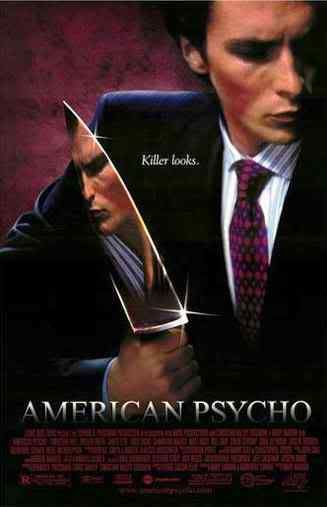


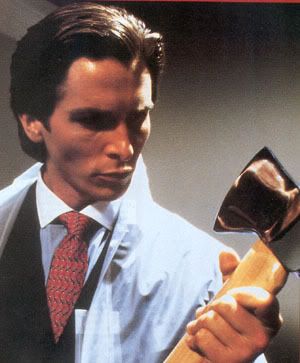
I live in the American Gardens Building on W. 81st Street on the 11th floor. My name is Patrick Bateman. I'm 27 years old. I believe in taking care of myself and a balanced diet and rigorous exercise routine. In the morning if my face is a little puffy I'll put on an ice pack while doing stomach crunches. I can do 1000 now. After I remove the ice pack I use a deep pore cleanser lotion. In the shower I use a water activated gel cleanser, then a honey almond body scrub, and on the face an exfoliating gel scrub. Then I apply an herb-mint facial mask which I leave on for 10 minutes while I prepare the rest of my routine. I always use an after shave lotion with little or no alcohol, because alcohol dries your face out and makes you look older. Then moisturizer, then an anti-aging eye balm followed by a final moisturizing protective lotion.


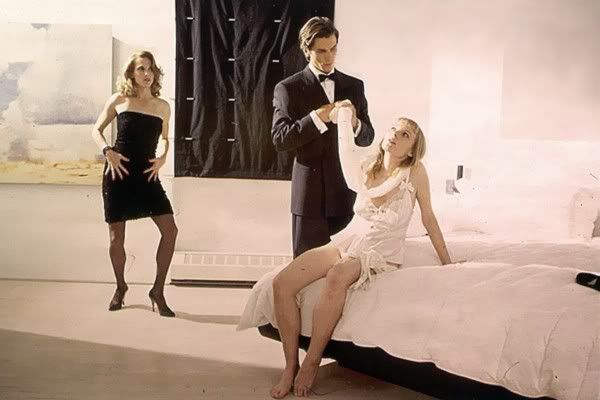
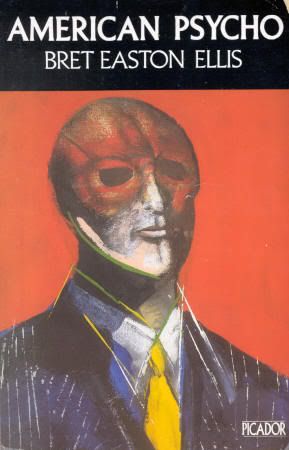

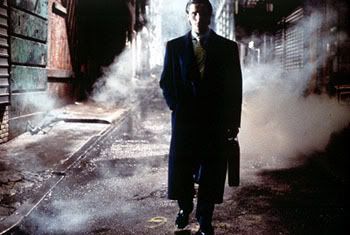
There is an idea of a Patrick Bateman; some kind of abstraction. But there is no real me: only an entity, something illusory. And though I can hide my cold gaze, and you can shake my hand and feel flesh gripping yours and maybe you can even sense our lifestyles are probably comparable... I simply am not there.
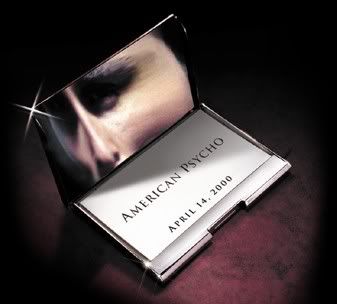
Business Card Scene
American Psycho Music Video
AMERICAN PSYCHO - Mad World
Hip To Be Square
by Huey Lewis And The News
Movie
American Psycho




I live in the American Gardens Building on W. 81st Street on the 11th floor. My name is Patrick Bateman. I'm 27 years old. I believe in taking care of myself and a balanced diet and rigorous exercise routine. In the morning if my face is a little puffy I'll put on an ice pack while doing stomach crunches. I can do 1000 now. After I remove the ice pack I use a deep pore cleanser lotion. In the shower I use a water activated gel cleanser, then a honey almond body scrub, and on the face an exfoliating gel scrub. Then I apply an herb-mint facial mask which I leave on for 10 minutes while I prepare the rest of my routine. I always use an after shave lotion with little or no alcohol, because alcohol dries your face out and makes you look older. Then moisturizer, then an anti-aging eye balm followed by a final moisturizing protective lotion.






There is an idea of a Patrick Bateman; some kind of abstraction. But there is no real me: only an entity, something illusory. And though I can hide my cold gaze, and you can shake my hand and feel flesh gripping yours and maybe you can even sense our lifestyles are probably comparable... I simply am not there.

Business Card Scene
American Psycho Music Video
AMERICAN PSYCHO - Mad World
Story of the Day-Gun Control
Penn and Teller Gun Control


Thomas Jefferson: "No man shall ever be debarred the use of arms. The strongest reason for the people to retain the right to keep and bear arms is, as a last resort, to protect themselves against tyranny in government."
"Laws that forbid the carrying of arms... disarm only those who are neither inclined nor determined to commit crimes... Such laws make things worse for the assaulted and better for the assailants; they serve rather to encourage than to prevent homicides, for an unarmed man may be attacked with greater confidence than an armed man. "
"And what country can preserve its liberties, if its rulers are not warned from time to time, that this people preserve the spirit of resistance? Let them take arms. ... The tree of liberty must be refreshed from time to time with the blood of patriots and tyrants."
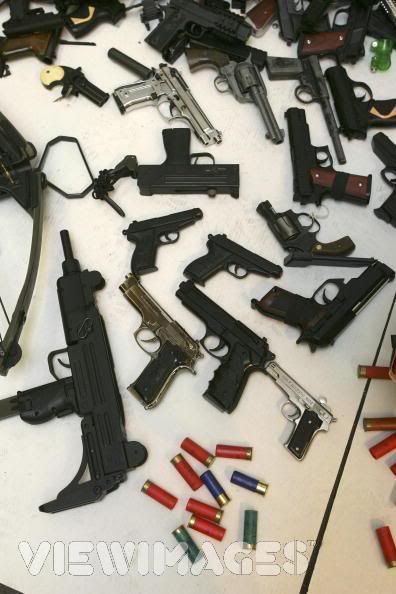
Second Amendment to the United States Constitution
Amendment II (the Second Amendment) of the United States Constitution, which is part of the Bill of Rights, declares a well regulated militia as "being necessary to the security of a free State", and prohibits Congress from infringement of "the right of the people to keep and bear arms."
http://en.wikipedia.org/wiki/Second_Amendment_to_the_United_States_Constitution
Gun politics
http://en.wikipedia.org/wiki/Gun_politics
Gun politics fundamentally involves the politics of two related questions: Does a government have valid authority to impose regulations on guns? And, assuming such authority, should a government regulate guns and to what extent?[1] The answer to these questions and the nature of the politics varies and depends on the national and local political jurisdiction.
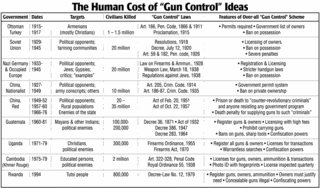
Gun Control
http://www.policyalmanac.org/crime/guns.shtml
Congress continues to debate the efficacy and constitutionality of federal regulation of firearms and ammunition. Various federal laws have been enacted since 1934 to promote such regulation.
Gun control advocates argue that they curb access by criminals, juveniles, and other "high-risk" individuals. They contend that only federal measures can successfully reduce the availability of guns. Some seek broad policy changes such as near-prohibition of non-police handgun ownership or the registration of all firearm owners or firearms. They assert that there is no constitutional barrier to such measures and no significant social costs. Others advocate less comprehensive policies that they maintain would not impede ownership and legitimate firearm transfers.
Opposition to federal controls is strong. Gun control opponents deny that federal policies keep firearms out of the hands of high-risk persons; rather, they argue, controls often create burdens for law-abiding citizens and infringe upon constitutional rights provided by the Second Amendment. Some argue further that widespread gun ownership is one of the best deterrents to crime as well as to potential tyranny, whether by gangs or by government. They may also criticize the notion of enhancing federal, as opposed to state, police powers.
The two most significant federal statutes controlling firearms in the civilian population are the National Firearms Act of 1934 and the Gun Control Act of 1968. The 1934 Act established strict registration requirements and a transfer tax on machine guns and short-barreled long guns. The 1968 Act prohibits mail-order sales and the interstate sales of firearms, prohibits transfers to minors, limits access to "new" assault weapons, and sets forth penalties and licensing requirements for manufacturers, importers, and dealers.
Crime and mortality statistics are often used in the gun control debate. The number of homicides committed annually with a firearm by persons in the 14- to 24-year-old age group increased by 173% from 1985 to 1993, and then decreased by 47% from 1993 to 1999. Firearm fatalities from all causes and for all age groups decreased by 22%. For juveniles, they de-creased by 40%, from 1993 to 1998.
The 106 th Congress considered several measures to regulate firearms. They included 1) requiring background checks at gun shows, 2) requiring firearm safety locks, and 3) increasing controls on assault weapons and handguns. None, however, were enacted. Several dozen gun control-related proposals have been introduced in the 107 th Congress. One measure has been approved by committee: this bill (H. R. 4757) would require that a greater number of federal and state records that are pertinent to determining firearms transfer and possession eligibility be made accessible through the National Criminal Instant Background Check System (NICS). NICS performance emerged as an issue during consideration of proposals that would require background checks for firearm transfers by nonlicensed persons at gun shows. Such proposals were considered in the 106 th Congress but have not been reconsidered in the 107 th Congress to date. A discharge petition on another measure was narrowly defeated by the House: this bill (H. R. 218) would exempt certain qualified current and former law enforcement officers from state laws prohibiting concealed carry of firearms.
BACKGROUND AND ANALYSIS
Pro/ Con Debate Through the years, legislative proposals to restrict the availability of firearms to the public have raised the following questions: What restrictions on firearms are permissible under the Constitution? Does gun control constitute crime control? Can the nation's rates of homicide, robbery, and assault be reduced by the stricter regulation of firearm commerce or ownership? Would restrictions stop attacks on public figures or thwart deranged persons and terrorists? Would household, street corner, and schoolyard disputes be less lethal if firearms were more difficult and expensive to acquire? Would more restrictive gun control policies have the unintended effect of impairing citizens' means of self-defense?
In recent years, proponents of gun control legislation have often held that only federal laws can be effective in the United States. Otherwise, they say, states with few restrictions will continue to be sources of guns that flow illegally into restrictive states. They believe that the Second Amendment to the Constitution, which states that "A well regulated Militia, being necessary to the security of a free State, the right of the people to keep and bear Arms shall not be infringed," (1) is obsolete; or (2) is intended solely to guard against suppression of state militias by the central government and therefore restricted in scope by that intent; or (3) does not guarantee a right that is absolute, but one that can be limited by reasonable requirements. They ask why a private citizen needs any firearm that is not designed primarily for hunting or other recognized sporting purposes.
Proponents of firearm restrictions have advocated policy changes on specific types of firearms or components that appear to be useful primarily for criminal purposes or that pose unusual risks to the public. Fully automatic firearms (i. e., machine guns) and short-barreled rifles and shotguns have been subject to strict regulation since 1934. Fully automatic firearms have been banned from private possession since 1986, except for those legally owned and registered with the Secretary of the Treasury on May 19, 1986. More recently, "Saturday night specials" (loosely defined as inexpensive, small handguns), "assault weapons," ammunition feeding devices with capacities for more than seven rounds, and certain ammunition have been the focus of control efforts.
Opponents of gun control vary in their positions with respect to specific forms of control but generally hold that gun control laws do not accomplish what is intended. They argue that it is as difficult to keep weapons from being acquired by "high risk" individuals, even under federal laws and enforcement, as it was to stop the sale and use of liquor during Prohibition. In their view, a more stringent federal firearm regulatory system would only create problems for law-abiding citizens, bring mounting frustration and escalation of bans by gun regulators, and possibly threaten citizens' civil rights or safety. Some argue that the low violent crime rates of other countries have nothing to do with gun control, maintaining instead that multiple cultural differences are responsible.
Gun control opponents also reject the assumption that the only legitimate purpose of ownership by a private citizen is recreational (i. e., hunting and target-shooting). They insist on the continuing need of people for effective means to defend person and property, and they point to studies that they believe show that gun possession lowers the incidence of crime. They say that the law enforcement and criminal justice system in the United States has not demonstrated the ability to furnish an adequate measure of public safety. Some opponents believe further that the Second Amendment includes a right to keep arms as a defense against potential government tyranny, pointing to examples in other countries of the use of firearm restrictions to curb dissent and secure illegitimate government power.
The debate has been intense. To gun control advocates, the opposition is out of touch with the times, misinterprets the Second Amendment, or is lacking in concern for the problems of crime and violence. To gun control opponents, advocates are naive in their faith in the power of regulation to solve social problems, bent on disarming the American citizen for ideological or social reasons, or moved by irrational hostility to firearms and gun enthusiasts.
Gun-Related Statistics
Number of Guns. The National Institute of Justice (NIJ) reported in a national survey that in 1994, 44 million people, approximately 35% of households, owned 192 million firearms, 65 million of which were handguns. Seventy-four percent of those individuals were reported to own more than one firearm. The Bureau of Alcohol, Tobacco, and Firearms (ATF) estimates that as of the end of 1996, approximately 242 million firearms were available for sale to or were possessed by civilians in the United States. That total includes roughly 72 million handguns (mostly pistols, revolvers, and derringers), 76 million rifles, and 64 million shotguns.
Most guns available for sale are produced domestically. In recent years, one to two million handguns were manufactured each year, along with one million rifles and less than one million shotguns. Annual imports are considerably fewer — from 200,000 to 400,000 handguns, 200,000 rifles, and 100,000 to 200,000 shotguns. Retail prices of guns vary widely, from $50 or less for inexpensive, low-caliber handguns to more than $1,500 for high-quality rifles or shotguns. Data are not available on the number of "assault weapons" in private possession or available for sale, but estimates prepared in 1989 by a firearms expert associated with the Smithsonian Institution placed the number of such firearms at that time in the range of one to four million, less than 3% of the number of guns estimated to exist in the civilian market.
Criminal Use. Reports submitted by state and local law enforcement agencies to the Federal Bureau of Investigation (FBI) and published annually in the Uniform Crime Reports indicate that both the crime rate and the violent crime rate have declined since 1981. Of the homicides in which the type of weapon could be identified, from 60% to almost 70% have involved firearms each year. The number of homicides and the proportion involving firearms have declined in recent years. In 2000 of the 12,943 homicides reported, 66% (8,493) were committed with firearms. Of those committed with firearms, 79% (6,686) involved handguns. From 1993 to1999, the number of firearm-related homicides decreased by an average rate of nearly 11% annually, for an overall decrease of 49%. In 2000, firearm-related homicides increased slightly (by 13 homicides) to 8,493.
The other principal source of national crime data is the National Crime Victimization Survey (NCVS) conducted by the Bureau of the Census and published by the Bureau of Justice Statistics. The NCVS database provides some information on the weapons used by offenders, based on victims' reports. Based on data provided by survey respondents in calendar year 1999, BJS estimated that, nationwide, there were 6.3 million violent crimes (rape or sexual assault, robbery, aggravated assault, and simple assault). Weapons were used in about 1.6 million of these criminal incidents. Firearms were used by offenders in about 533,000 of these incidents, or roughly 8%. For further information, see Criminal Victimization 2000: Changes 1999-2000 with Trends 1993-2000, by Callie Marie Rennison [http:// www. ojp. usdoj. gov/ bjs/ pub/ pdf/ cv00. pdf].
Gun Violence and Youth. Youth crime statistics have often been used in the gun control debate. The number of homicides committed annually with a firearm by persons in the 14-to 24-year-old age group increased sharply from 1985 to 1993; they have declined since then, but not to the 1985 level. According to the Bureau of Justice Statistics, from 1985 to 1993, the number of firearm-related homicides committed by 14-to 17-year-olds increased by 294%, from 855 to 3,371. From 1993 to 1999, the number of firearm-related homicides committed by persons in this age group decreased by 65%, from 3,371 to 1,165.
From 1985 to 1993, firearm-related homicides committed by 18-to 24-year-olds increased by 142%, from 3,374 to 8,171. From 1993 to 1999, firearm-related homicides committed by persons in this age group decreased by 43%, from 8,717 to 4,973. For further information, see Homicide Trends in the United States, by James Alan Fox, at [http:// www. ojp. usdoj. gov/ bjs/ homicide/ homtrnd. htm].
Although gun-related violence in schools is statistically a rare event, a Department of Justice survey indicated that 12.7% of students age 12 to 19 reported knowing a student who brought a firearm to school. For further information, see CRS Report RL30482, The Safe and Drug-Free Schools and Communities Program: Background and Context, by Edith Fairman Cooper.
Suicides, Accidents, and Other Deaths. Firearm fatalities have decreased continuously since 1993. The source of national data on firearm deaths is the publication Vital Statistics, published each year by the National Center for Health Statistics. Firearm deaths reported by coroners in each state are presented in four categories: homicides and legal intervention, suicides, accidents, and unknown circumstances. In 1999, a total of 28,874 firearm deaths occurred, according to such reports. Of this total, 11,127 were homicides or due to legal intervention; 16,599 were suicides; 824 were unintentional (accidental) shootings; and 324 were of unknown cause. From 1993 to 1998, firearm-related deaths decreased by an average rate of 5% annually, for an overall decrease of 27%. Also in 1999, there were 1,776 juvenile (under 18 years of age) deaths attributed to firearms. Of the juvenile total, 1,010 were homicides or due to legal intervention; 558 were suicides; 158 were unintentional; and 50 were of unknown cause. From 1993 to 1999, firearm-related deaths for juveniles have decreased by an average rate of 10% annually, for an overall decrease of 46%.
Self-defense. According to the Bureau of Justice Statistics, NCVS data from 1987 to 1992 indicate that in each of those years, roughly 62,200 victims of violent crime (1% of all victims of such crimes) used guns to defend themselves. Another 20,000 persons each year used guns to protect property. Persons in the business of self-protection (police officers, armed security guards) may have been included in the survey. Another source of information on the use of firearms for self-defense is the "National Self Defense Survey" conducted by criminology professor Gary Kleck of Florida State University in the spring of 1993. Citing responses from 4,978 households, Dr. Kleck estimated that handguns have been used 2.1 million times per year for self-defense, and that all types of guns have been used approximately 2.5 million times a year for that purpose, during the 1988-1993 period.
Why do these numbers vary? Law enforcement agencies do not collect information on the number of times civilians use firearms to defend themselves or their property against attack. Such data have been collected in household surveys. The contradictory nature of the available statistics may be partially explained by methodological factors. That is, these and other criminal justice statistics reflect what is reported to have occurred, not necessarily the actual number of times certain events occur. Victims and offenders are sometimes reluctant to be candid with researchers. So, the number of criminal incidents can only be estimated, making it difficult to state with certainty the accuracy of statistics such as the number of times firearms are used in self-defense. For this and other reasons, criminal justice statistics often vary when different methodologies are applied.
Survey research can be limited, since it is difficult to produce statistically significant findings from small incident populations. For example, the sample in the National Self-Defense Survey might have been too small, given the low incidence rate and the inherent limitations of survey research.
Recreation. According to the National Institute of Justice (NIJ), in 1994 recreation was the most common motivation for owning a firearm. There were approximately 15 million hunters, about 35% of gun owners, in the United States and about the same number and percentage of gun owners engaged in sport shooting in 1994. The U. S. Fish and Wildlife Service reported that 31.6 million persons purchased hunting licenses or permits in 1993 and, according to the National Sporting Goods Association, in that year approximately 18.5 million persons took part in firearms sporting activities.
Federal Regulation of Firearms As stated in the Gun Control Act of 1968, as amended (P. L. 90-618; Title 18, United States Code, Chapter 44), the purpose of federal firearm regulation is to assist federal, state, and local law enforcement in the ongoing effort to reduce crime and violence. In the same act, however, Congress also stated that the intent of the law is not to place any undue or unnecessary burdens on law-abiding citizens in regard to the lawful acquisition, possession, or use of firearms for hunting, trapshooting, target shooting, personal protection, or any other lawful activity.
Indeed, issues related to federal firearm regulation currently under debate generally revolve around the following questions. One, who should be ineligible to possess firearms? Two, what types of firearms are appropriate for statutorily enumerated lawful firearm activities? Three, when, where, and how is it appropriate to check persons seeking to acquire a firearm for possession eligibility?
Federal Regulation of Firearm Transfers. Under current law, federal firearm licensees (hereafter referred to as licensees) may ship, transport, and receive firearms that have moved in interstate and foreign commerce. Licensees are currently required to verify with the Federal Bureau of Investigation (FBI) through a background check that nonlicensed persons are eligible to possess a firearm before subsequently transferring a firearm to them. Licensees must also verify the identity of nonlicensed transferees by inspecting a government-issued identity document, e. g., a driver's license.
Under current law, there are 9 classes of persons prohibited from possessing firearms: 1) persons convicted in any court of a crime punishable by imprisonment for a term exceeding 1 year; 2) fugitives from justice; 3) drug users, or addicts; 4) persons adjudicated mental defectives, or committed to mental institutions; 5) unauthorized immigrants; 6) persons dishonorably discharged from the Armed Forces; 7) U. S. citizenship renunciates; 8) persons under court-order restraints related to harassing, stalking, or threatening an intimate partner or child of such intimate partner; and 9) persons convicted of misdemeanor domestic violence (18 U. S. C. § 922( g)).
Licensees may engage in interstate transfers of firearms between themselves without conducting background checks. While they may transfer long guns (rifles or shotguns) to out-of-state residents, as long as there are in-person meetings and such transfers would not knowingly be in violation of the laws of the state in which the nonlicensed transferees reside, they may not transfer handguns to unlicensed out-of-state residents. Transfer of handguns by licensees to anyone under 21-years-of-age is prohibited, as is the transfer of long guns to anyone under 18-years-of-age (18 U. S. C. § 922( b)). Also, licensees are required to submit a "multiple sales reports" to the Secretary of the Treasury if any person purchases two or more handguns within 5 business days.
Furthermore, licensees are required to maintain records on all acquisitions and dispositions of firearms. They are obligated to respond to Bureau of Alcohol, Tobacco and Firearms (ATF) agents requesting firearm tracing information within 24 hours. Under certain circumstances, ATF agents may inspect, without search warrants, their business premises, inventory, and records.
On the other hand, nonlicensees are prohibited from acquiring firearms from out-of-state sources (except for long guns acquired from licensees under the scenario described above). Nonlicensees are also prohibited from transferring firearms to any persons who they have reasonable cause to believe are not residents of the state in which the transaction occurs. In addition, since 1986, it has been a federal offense for nonlicensees to knowingly transfer a firearm to prohibited persons. It is also notable that firearm transfers initiated through the Internet are subject to the same federal laws as transfers initiated in any other manner. (For further information, see CRS Report RS20957, Internet Firearm Sales, by T. J. Halstead.)
Finally, since 1994, it has been a federal offense for any nonlicensed person to transfer a handgun to anyone under 18-years-of-age. It has also been illegal for anyone under the under 18 years-of-age to possess a handgun (there are exceptions to this law related to employment, ranching, farming, target practice, and hunting) (18 U. S. C. § 922( x)).
Brady Act Implementation. According to the Bureau of Justice Statistics, since the implementation of the Brady Act on February 29, 1994, through calender year (CY) 2000, nearly 30 million firearm background checks were completed, resulting in 689,000 denials (an overall 2.3% denial rate). During the interim period of the Brady Act (phase I), from February 1994 through November 1998, there was a waiting period of up to 5 days for handgun transfers in states without instant check systems. Nearly 13 million firearm background checks were completed, resulting in 312,000 denials.
Phase II and the permanent provisions of the Brady Act became effective on November 30, 1998. As part of phase II, the Federal Bureau of Investigation rolled out the National Instant Criminal Background Check System (NICS). Through NICS, and under the permanent Brady provisions, background checks are conducted of applicants for both hand and long gun transfers. In 26 states, state agencies serve as points of contact (POCs) and conduct background checks for handgun transfers. In 16 states, state agencies serve as POCs and conduct background checks for both long gun and handgun transfers. In POC states, federal firearm licensees contact the state agency, and the state agency contacts the FBI. In non-POC states, federal firearm licensees contact the FBI directly through the NICS system.
During the first 25 months of NICS operation (through December 31, 2000), the FBI completed over 17 million background checks for firearm transfer applications. Of this number, 639,000 background checks resulted in firearm transfers being denied. Roughly half of these background checks were submitted by federal firearm licensees, and the other half by state agencies (POCs). The overall number of firearm transfer applications and required background checks declined by 11% from 8.6 million in CY1999 to 7.7 million in CY2000. Of total checks in FY2000, 2.0% (153,000) resulted in denials. Over 59% of denials occurred because the applicant was a felon or was under felony indictment, as compared to 72% in FY1999. The next most common reason for denial, about 12% of cases in FY2000, was a domestic violence misdemeanor conviction or restraining order. For further information on phase II, see Background Checks for Firearm Transfers, 2000 (Washington, July 2001), at [http:// www. ojp. usdoj. gov/ bjs/ abstract/ bcft00. htm].
According to GAO, about 75% of the NICS checks handled by the FBI resulted in immediate determinations of eligibility. Of the remaining 25% that resulted in a non-definitive response, neither a "proceed" nor a denial, 80% were turned around within 2 hours. The remaining 20% of delayed transactions took hours or days for the FBI NICS examiners to reach a final determination. In many cases these sales were delayed because there was an outstanding charge without a final disposition against the person seeking to purchase the firearm. Such cases necessitate that the FBI examiners contact local or state authorities for additional information. Under current law, the FBI is authorized to delay the sale for 3 business days in order to determine the outcome of the charge and, thus, establish the eligibility of the transferee to possess a firearm.
NICS system availability --how regularly the system can be accessed during business hours and not delay legitimate firearm transfers --has also been a source of complaint. GAO found, however, that in the first year of NICS operation, the FBI had achieved its system availability goal of 98% for 4 months. System availability for the remaining 8 months averaged 95.4%. For further information, see GAO Report GGD/ AIMD-00-64, Gun Control: Implementation of the National Instant Criminal Background Check System (Washington, February 2000).
For state agencies, background checks may not be as expeditious. Background checks through state agencies, however, may be more thorough, since state agencies may have greater access to databases and records that are not available through NICS. For further information, see National Instant Criminal Background Check System (NICS): Operations Report (November 30 1998 -December 31, 1999) (Washington, revised August 1, 1999), at [http:// www. fbi. gov/ hq/ cjisd/ nics/ index. htm], click on "NICS One Year Report."
Federal Firearm Prosecutions. Regarding enforcement of the Brady Act, from November 1998 through June 2000, the FBI referred 134,522 Brady-related cases to the ATF, and 37,926 of these cases were referred to ATF field offices for investigation. According to ATF, in FY2000 there were 1,485 defendants charged with firearm-related violations as a result of NICS checks under Brady. Of these defendants, 1,157 were charged with providing falsified information to federal firearm licensees (18 U. S. C. § 922( a)( 6)), another 86 were persons ineligible to posses firearms under the domestic violence gun ban (18 U. S. C. §§ 922( g)( 8) and (9)), and 136 were convicted felons (18 U. S. C. § 922( g)( 1)).
According to the Bureau of Justice Statistics, however, federal firearm prosecutions decreased by 19% from 1992 to 1996, they leveled off through 1997, and increased in 1998 and 1999. The decline in federal prosecutions can be attributed in part to a Supreme Court decision (Bailey v. United States (516 U. S. 137, 116 S. Ct. 501)) that limited the use of the charge of using a firearm during a violent or drug-related offense (18 United States Code, § 924( c)). See Federal Firearm Offenders, 1992-98 (with Preliminary Data for 1999) (Washington, June 2000), at [http:// www. ojp. usdoj. gov/ bjs/ pub/ pdf/ ffo98. pdf].
Major Federal Firearm Statutes. Two major federal statutes regulate the commerce in firearms, or their ownership: the National Firearms Act of 1934 (26 U. S. C. § 5801 et seq.) and the Gun Control Act of 1968, as amended (18 U. S. C. Ch. 44, § 921 et seq.). The National Firearms Act was originally designed to make it difficult to obtain types of firearms perceived to be especially lethal or to be the chosen weapons of "gangsters," most notably machine guns and short-barreled long guns. This law also regulates firearms, other than pistols or revolvers, that can be concealed on a person (e. g., pen, cane, and belt buckle guns). It taxes all aspects of the manufacture and distribution of such weapons. And, it compels the disclosure (through registration with the Secretary of the Treasury) of the production and distribution system from manufacturer to buyer.
The Gun Control Act of 1968, as amended, contains the principal federal restrictions on domestic commerce in small arms and ammunition. The statute requires all persons manufacturing, importing, or selling firearms as a business to be federally licensed; prohibits the interstate mail-order sale of all firearms; prohibits interstate sale of handguns generally, sets forth categories of persons to whom firearms or ammunition may not be sold (such as persons under a specified age or with criminal records); authorizes the Secretary of the Treasury to prohibit the importation of non-sporting firearms; requires that dealers maintain records of all commercial gun sales; and establishes special penalties for the use of a firearm in the perpetration of a federal drug trafficking offense or crime of violence. Transactions between persons "not engaged in the business" are not covered by the Act. These transactions and other matters such as possession, registration, and the issuing of licenses to the owners of firearms maybe covered by state laws or local ordinances. It also prohibits federal firearm licensees from selling or delivering a rifle or shotgun to a person under 18 years of age, or a handgun to a person under 21 years of age.
Supplementing federal law, many state firearm laws are stricter than federal law. For example, some states require permits to obtain firearms and impose a waiting period for firearm transfers. Other states are less restrictive, but state law cannot preempt federal law. Federal law serves as the minimum standard in the United States.
The following principal changes have been enacted to the Gun Control Act since 1968.
The "Firearms Owners Protection Act," McClure-Volkmer Amendments (P. L. 99-308, 1986) eases certain interstate transfer and shipment requirements for long guns, defines the term "engaged in the business," eliminates some record-keeping requirements, and bans the private possession of machine guns not legally owned prior to 1986.
The "Armor Piercing Ammunition" Ban (P. L. 99-408, 1986, amended in P. L. 103-322, 1994) prohibits the manufacture, importation and delivery of handgun ammunition composed of certain metal substances and certain full-jacketed ammunition.
The Federal Energy Management Improvement Act of 1988 (P. L. 100-615) requires that all toys or firearm look-alikes have a blazed orange plug in the barrel, denoting that it is a non-lethal imitation.
The Undetectable Firearms Act (P. L. 100-649, 1988), also known as the "plastic gun" legislation, bans the manufacture, import, possession, and transfer of firearms not detectable by security devices.
The Gun-Free School Zone Act of 1990 (P. L. 101-647), as originally enacted, was ruled unconstitutional by the U. S. Supreme Court (United States v. Lopez, 514 U. S. 549 (1995), April 26, 1995). The Act prohibited possession of a firearm in a school zone (on the campus of a public or private school or within 1,000 feet of the grounds). In response to the Court's finding that the Act exceeded Congress's authority to regulate commerce, the 104 th Congress included a provision in P. L. 104-208 that amended the Act to require federal prosecutors to include evidence that the firearms "moved in" or affected interstate commerce.
The Brady Handgun Violence Prevention Act, 1993 (P. L. 103-159) requires that background checks be completed on all nonlicensed person seeking to obtain firearms from federal firearm licensees.
The Violent Crime Control and Law Enforcement Act of 1994 (P. L. 103-322) prohibits the manufacture or importation of semiautomatic assault weapons and large capacity ammunition feeding devices (for a 10-year period). In the case of large capacity ammunition feeding devices, the ban on importation applies to those devices manufactured after September 1994. This Act provides an exception for the transfer, sale, or possession of semiautomatic assault weapons and large capacity ammunition feeding devices lawfully possessed on the date of enactment. This Act also bans the sale or transfer of handguns and handgun ammunition to, or possession of handguns and handgun ammunition by, juveniles (under 18 years of age) without prior written consent from the juvenile's parent or legal guardian; exceptions related to employment, ranching, farming, target practice, and hunting are provided. In addition, the Act disqualifies persons under court orders related to domestic abuse from receiving a firearm from any person or possessing a firearm. It also enhances penalties for the criminal use of firearms and makes other changes to existing law.
Federal Domestic Violence Gun Ban (the Lautenberg Amendment, in the Omnibus Consolidated Appropriations Act for FY1997, P. L. 104-208) prohibits persons convicted of misdemeanor crimes of domestic violence from possessing firearms and ammunition. The ban applies regardless of when the offense was adjudicated: prior to, or following enactment. It has been challenged in the federal courts, but these challenges have been defeated. (See CRS Report RL31143, Firearms Prohibitions and Domestic Violence Convictions: The Lautenberg Amendment, by T. J. Halstead.)
The Omnibus Consolidated and Emergency Appropriations Act, 1999 (P. L. 105-277), requires all federal firearm licensees to offer for sale gun storage and safety devices. It also bans firearm transfers to, or possession by, nonimmigrants who have overstayed their the terms of their temporary visa.
The Treasury, Postal and General Government Appropriations Act (P. L. 106- 58) requires that background checks be conducted when former firearm owners seek to redeem a firearm that they sold to a pawnshop.
Possible Issues for the 107 th Congress Several dozen gun control-related proposals have been introduced in the 107 th Congress. One of these measures has been approved by committee: this bill (H. R. 4757) would require that a greater number of federal and state records that are pertinent to determining firearms transfer and possession eligibility be made accessible through the National Criminal Instant Background Check System (NICS). NICS performance and robustness emerged as an issue during consideration of proposals that would require background checks for firearm transfers by nonlicensed persons at gun shows. Such proposals were considered in the 106 th Congress but have not been reconsidered in the 107 th Congress to date. In addition, a discharge petition on another measure was narrowly defeated by the House: this bill (H. R. 218) would exempt certain qualified current and former law enforcement officers from state laws prohibiting concealed carry of firearms.
Gun Shows. Federal law does not regulate gun shows specifically. Federal law regulating firearms transfers, however, is applicable to such transfers at gun shows. Federal firearm licensees – those licensed by the federal government to manufacture, import, or deal in firearms – are required to conduct background checks on non licensed persons seeking to obtain a firearm from them, by purchase or exchange. Conversely, non licensed persons – those persons who transfer firearms, but who do not meet the statutory test of being "engaged in the business" – are not required to conduct such checks. To some, this may appear to be an incongruity in the law. Why should licensees be required to conduct background checks at gun shows, and not non licensees? To others, opposed to further federal regulation of firearms, it may appear to be a continuance of the status quo, i. e., non-interference by the federal government into private firearm transfers within state lines. On the other hand, those seeking to increase federal regulation of firearms may view the absence of background checks for firearm transfers between non licensed/ private persons as a loophole in the law that needs to be closed. At issue for Congress is whether federal regulation of firearms should be expanded to include private firearm transfers at gun shows and other similar venues.
It is currently unclear what the Bush Administration's position will be on gun shows and NICS checks. During the presidential candidate debates, then candidate, now President, George W. Bush stated that he favored extending background checks to all firearm transfers at gun shows. More recently, President Bush stated that he supported such checks if they could be completed within 24 hours. Among gun show-related bills introduced in the 107 th Congress, there are basically two legislative proposals. The first, which passed the Senate in the 106 th Congress, is known by its sponsor in the 106 th Congress, former Senator Frank Lautenberg. Proposals modeled on the Lautenberg language have been included in the following bills introduced in the 107 th Congress: S. 16, S. 767, S. 940, H. R. 1990, and H. R. 4034. The last bill (H. R. 4034) was introduced by the ranking member of the Judiciary Committee, Representative John Conyers. The second proposal, introduced as S. 890, is known by its sponsors in the 107 th Congress, Senators John McCain and Joseph Lieberman. This second proposal has also been introduced in the House as H. R. 2377 by Representative Michael Castle. Both proposals address several questions.
How would the term "gun show" be defined? The Lautenberg proposal defines a gun show as any event at which 50 or more firearms are offered for sale or transfer and there are not less than 10 vendors. Instead of gun show, the McCain/ Lieberman proposal uses the term "special firearms event," defining it as any event at which 75 or more firearms are offered for sale or transfer. ! Should gun show promoters/ special firearms event operators be required to register with the Secretary of the Treasury? Both bills would require promoters/ operators to register with the Secretary of the Treasury. Unlike the Lautenberg proposal, the McCain/ Lieberman proposal would also require frequent operators who organize two or more of these events in a 6-month period to be licensed, and it would require both frequent and infrequent operators to submit ledgers of nonlicensed vendors before and after each event to the Secretary of the Treasury. ! Should all firearms transactions at gun shows be conducted by federal firearm licensees, or should a special licensee be responsible for conducting NICS checks for nonlicensees? The Lautenberg proposal adopts the former approach, the McCain/ Lieberman, the latter. Also, the McCain/ Lieberman proposal would prohibit special licensees from displaying firearms for sale or transfer at events where they are designated to conduct background checks for nonlicensees. ! How many days should the FBI be given to complete background checks at gun shows? The Lautenberg proposal does not address this issue, leaving in place the current statutory 3 business day delayed sale. In contrast, the McCain/ Lieberman proposal would establish a certification process by which states could opt for a maximum 24-hour delayed sale, when 95% of the state's disqualifying records (criminal and otherwise) going back 30 years are made available online.
For further information on gun shows, see Gun Shows: Brady Checks and Crime Gun Traces (Washington: January 1999). See: http:// www. atf. treas. gov/, click on "Publications."
Project Exile. Both gun control supporters and opponents are likely to call for greater enforcement of existing federal gun control statutes. Many maintain that "Project Exile" is a useful model upon which to build increased federal gun prosecutions. An initiative mounted by the U. S. Attorney for the Eastern District of Virginia, "Project Exile" was a concerted effort to coordinate federal, state, and local law enforcement efforts to reduce gun violence in Richmond, Virginia. At that time, Richmond had the second highest homicide rate for cities with populations of 100,000 or more. Of those homicides, 80% were committed with a firearm. As part of Project Exile, the U. S. Attorneys reviewed cases that involved felons, drug users/ traffickers, domestic violence and firearms, and these cases were singled out for prosecution in federal court. A felon caught carrying a firearm while trafficking in drugs was very likely to be sentenced to 5 years in a federal prison (18 U. S. C. § 924( c)). From 1997 to 1998, the number of homicides in Richmond dropped by 31%, and this decrease has been attributed to Project Exile. U. S. Attorneys in other major metropolitan areas have adopted this approach.
In the 106 th Congress, the House passed the Project Exile: The Safe Streets and Neighborhoods Act of 2000 (H. R. 4051). This bill would have amended the Violent Crime Control and Law Enforcement Act of 1994 (P. L. 103-322) to create a program to provide firearms sentencing incentive grants to encourage states to adopt programs that would be similar to Project Exile. For similar legislation introduced in the 107 th Congress, see H. R. 534, S. 16, and S. 619.
Background Check Record Retention and Fees. Attorney General John Ashcroft recently announced that National Instant Background Check System (NICS) records on approved sales would be destroyed after 24 hours retention. He maintains that to keep these records longer was a violation of federal law. Previously, the Department of Justice published a rule that would reduce from 6 to 3 months the length of time that the Federal Bureau of Investigation would retain such information on approved sales (see 64 Fed. Reg. 10263-10265, March 3, 1999). The National Rifle Association (NRA) had challenged the DOJ rule to retain the records on approved sales for 6 months in federal court. On July 11, 2000, however, the United States Court of Appeals for the District of Columbia, in the case of NRA v. Reno (No. 99-5270, 216 F. 3d 122; 2000 U. S. App. Lexis 15906), found that nothing in the Brady Handgun Violence Prevention Act prohibits the temporary retention of information about lawful firearm transfers. According to GAO, next-day destruction of records may not adversely affect routine NICS audits to determine the accuracy of eligibility decisions made by NICS examiners, if such audits are done on an hourly or daily basis. However, next-day destruction of records may adversely affect non-routine audits, such as when a law enforcement agency requests information about a firearm transfer that NICS records show was allowed, but subsequent information shows that the transferee was ineligible to receive a firearm. For further information, see GAO Report GAO-02-653, Gun Control: Potential Effects of Next-Day Destruction of NICS Background Check Records (Washington: July 2002).
In regard to fees, the FY2002 Commerce-Justice-State appropriations act (P. L. 107-77) includes a provision that prohibits user fees being charged for background checks under the Brady Handgun Prevention Act.
Federal and State Background Check Records. The House Judiciary Committee amended and approved a bill to improve the National Instant Background Check System (NICS) on July 23, 2002. This bill, "Our Lady of Peace Act" (H. R. 4757), was introduced by Representative Carolyn McCarthy. Among other things, this bill would: (1) amend the Brady Handgun Violence Prevention Act to require federal agencies to provide, and the Attorney General to secure, any government records with information relevant to determining the eligibility of a person to receive a firearm for inclusion in NICS; (2) require states to make available to the Attorney General certain records that would disqualify persons from acquiring a firearm, particularly those records that relate to convictions for misdemeanor crimes of domestic violence and persons adjudicated as mental defective; and (3) authorize appropriations for grant programs to assist states, courts, and local governments in establishing or improving such automated record systems.
Concealed Carry. Several bills introduced in the 107 th Congress would exempt certain qualified current and former law enforcement officers from state laws prohibiting concealed carry of firearms (H. R. 218, H. R. 255, H. R. 382, S. 442, and S. 2480). The most recent bill (S. 2480) was introduced by Senator Patrick Leahy – the Chair of the Senate Judiciary Committee, and Senator Orrin Hatch – the committee's ranking minority member, at the request of the Fraternal Order of Police. The Senate bill is nearly identical to a measure (H. R. 218) introduced by Representative Randy Cunningham. A discharge petition on H. R. 218, which would have required House consideration of this bill, was narrowly defeated on November 13, 2001. Concealed carry of firearms has traditionally been a matter of state law. In states that allow concealed carry, there are two types of laws: "may issue" and "shall issue." States with discretionary, or "may issue," laws leave the decision to issue or deny permits with the issuing authority (usually the state police). States with non-discretionary, or "shall issue," laws require that permits be issued to applicants who meet certain criteria.
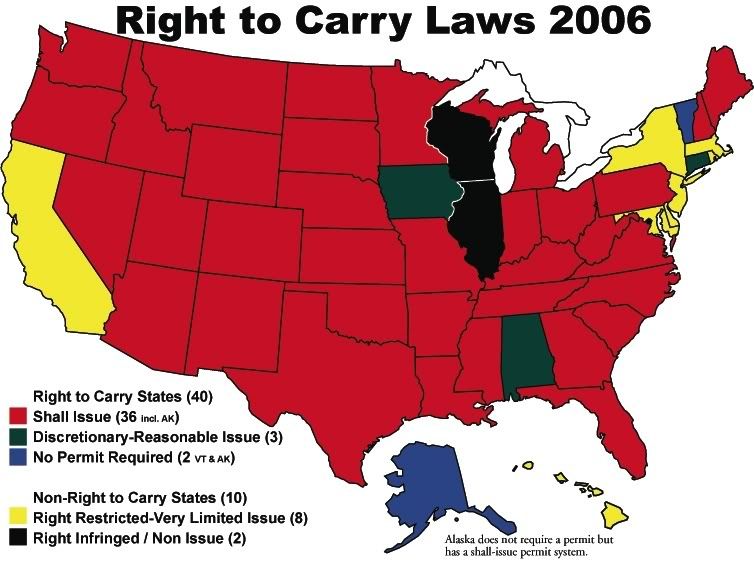
SO YOUWANNA KNOW ABOUT GUN CONTROL?
http://www.soyouwanna.com/site/pros_cons/guncontrol/guncontrol.html


Milestones in Federal
Gun Control Legislation
http://www.infoplease.com/spot/guntime1.html
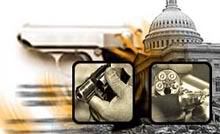
This listing of facts is derived from over 200 hours of research and analysis of more than 100 articles, documents, and books. Every statistic from a given year was chosen based on availability, and not to slant the results by singling out a specific year that was different from others. Especially when dealing with statistics, the determination of what constitutes a credible fact and what does not, can contain elements of personal subjectivity. It is our mission to minimize subjective information and to provide highly factual content. Therefore, we are taking the additional step of giving our readers a tool to determine for themselves the viability of our work. To that end, we have provided four examples to illustrate the type of material that was excluded because it did not meet Just Facts' Standards of Credibility.
http://www.justfacts.com/issues.guncontrol.asp
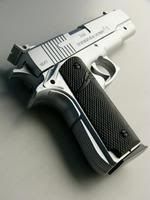
The history of gun control, part 1
http://worldnetdaily.com/news/article.asp?ARTICLE_ID=56047
Philosopher George Santayana said that those who cannot remember the past are condemned to repeat it. It's true. One of the reasons to study history is to avoid repeating past mistakes. When it comes to freedom, we cannot afford to forget the lessons of the past. So you and I need to know the history of gun control, because history teaches us there is a terrible price to pay when we lose our right to keep and bear arms.
Over 200 years ago, when the Founding Fathers drafted the Second Amendment, no one questioned the need for private gun ownership. The Framers considered private firearms to be essential to protecting personal liberty, both as a means of opposing foreign threats and also as a check against excessive government power. The Framers were passionately devoted to the idea that a self-sufficient armed citizenry is the best means of preserving liberty.
But many on the left do not want you to know this. They keep the truth from being taught in public schools, and they even write books laden with falsehoods in a dishonest attempt to rewrite history.
Seven years ago, Emory University historian Michael Bellesiles published a book purportedly proving there were few guns and gun owners in early America. The book garnered Columbia University's coveted Bancroft Prize. Two years later, primarily due to the efforts of a brilliant young research historian, Clayton Cramer, who had studied that period in history extensively, the book was revealed to be a total fraud, full of lies and fabrications. Bellesiles was forced to resign from Emory University and, for the first time in history, Columbia University rescinded the Bancroft Prize.
Every American who values his or her constitutional rights should know something about these frauds that gun control advocates perpetrate so we can be watchful and teach the truth to our young ones.
Early Americans were gun owners. Private firearm ownership was widespread from the coasts to the frontier, in both the North and the South.
Our ancestors not only knew the value of gun rights, they actually practiced those rights. Many early Americans provided for their family through their skill with a firearm, and many more Americans had a gun hanging over the hearth or in the bedroom to protect the house and the children against wild animals or criminals. These firearms were also seen as an insurance policy against American Indians, the British or French, and even against our own central government.
This honored tradition went completely unchallenged until the 1900s. Then New York passed the Sullivan Act in 1911, one of the first gun control laws. This law required that firearms small enough to be concealed on a person be registered. This state law became a test measure for future gun control laws.
Opponents of the Second Amendment started to mobilize at the federal level in the 1930s. It came during the New Deal, when the federal government was growing rapidly. Two laws enacted during this period, the National Firearms Act of 1934 and the Federal Firearms Act of 1938, established the first federal gun controls. While most of these regulations were uncontroversial by current standards (such as licensing gun dealers and regulating possession of machine guns), they introduced the concept of national regulation of firearms.
It was also during this time President Franklin Roosevelt appointed a number of liberals to the United States Supreme Court. Starting in 1937, the high court began moving in a liberal direction, and by the 1960s had become a court favoring full judicial activism, a judicial philosophy that has threatened our Second Amendment rights ever since.
During this period, anti-Second Amendment politicians began testing the waters on gun control. The highest-ranking official to do this was FDR's anti-gun attorney general, Homer Cummings. Attorney General Cummings started planning for federal gun control measures such as a national registry in the hands of the central government for guns and gun owners.
But then World War II broke out, and Germany and Japan invaded their neighbors. The American people were reminded how important it is to have a firearm handy when you need one. Cummings' early attempts to regulate guns and gun owners suddenly became unpopular. Gun control advocates lowered their voices until a more opportune time.
Most American leaders in both political parties were pro-gun. In fact, Democratic presidents Harry Truman and John F. Kennedy were NRA members. Gun control advocates were always present in policy debates, but did not have much political clout.
In the 1960s, gun control came back with a vengeance. Modern liberalism became the dominant political philosophy in this country. And after the deaths of JFK, Robert Kennedy and Martin Luther King Jr., an all-out national push for gun control was launched.
This period in the late 1960s was the beginning of significant gun control in America. Liberal activist judges, led by the Warren Court, enacted a widespread liberal agenda. American society was being secularized. President Johnson was forcing a hard-left agenda through the Great Society. And the Vietnam War was becoming increasingly unpopular. It was against that backdrop the left finally launched an open, concerted effort to implement national gun control.
And that's what we'll talk about next week, remembering that if we ignore the lessons that history offers us, our children will pay the price with their freedom.
The history of gun control, part 2
http://worldnetdaily.com/news/article.asp?ARTICLE_ID=56156
Until Lyndon Johnson came to the White House in 1963 following the assassination of President John F. Kennedy, gun control was simply not a national issue. There were no significant federal gun control laws on the books, and the NRA was a shooter's organization that intentionally shied away from any political involvement.
All of that changed with the 1968 assassinations of Sen. Robert Kennedy and civil rights leader Martin Luther King. In the civil unrest that followed, the media found a new whipping boy – America's gun owners. The media blitz against gun rights was unprecedented and became the driving force behind Democrat leaders proposing national gun control.
Although JFK and his brother, Sen. Robert Kennedy, had been NRA Life Members, America's new president, Lyndon Johnson, was a committed gun control advocate. No president ever matched his power and his will when it came to controlling the legislative process. His attorney general and much of his senior staff searched for new ways to restrict gun ownership among the American people. This was part of Johnson's Great Society vision of an all-powerful federal government controlling the lives of ordinary Americans.
LBJ also put anti-gun judges on the federal courts at every level. Liberal Thurgood Marshall, an opponent of the Second Amendment, was appointed to the United States Supreme Court. All three branches of the federal government lurched to the left in most policy areas, including firearms.
Keep in mind that up until this time, private ownership of firearms was not in any meaningful way controlled by the federal government. Johnson's administration was the beginning of the federal government superseding state authority in all aspects of people's lives, including ownership and lawful commerce in their private property – in this case, firearms.
The other major factor that created the federal gun control movement was that the NRA, as an organization, was totally unprepared to deal with the media, Lyndon Johnson, or the anti-gun politicians in the U.S. House and Senate. Up until that point, NRA refused even to have a registered lobbyist. In fact, NRA sent mixed signals to the Hill in reference to Johnson's anti-gun legislation.
If NRA had held nominally pro-gun House members' feet to the fire, the 1968 Gun Control Act, or GCA, would not have become law. With no direction from NRA, however, those legislators simply didn't vote. And the worst piece gun control legislation in history was enacted into law.
GCA made many common gun-related commercial activities federal crimes. Suddenly, firearm sales became heavily regulated and restricted. Some supporters of GCA saw it as the first step toward the ultimate goal of ending private gun ownership in the United States. The GCA has served as the basis of virtually every piece of gun control legislation, federal or state, that has been enacted since.
Nothing changed politically for gun owners until former NRA President Harlon Carter, a true visionary and often a lone voice on the NRA board, convinced NRA that gun owners needed a powerful grass-roots lobby focused on saving the Second Amendment.
Following Senate passage of a Saturday Night Special bill, which would have banned one-third of the handgun designs in the United States, Harlon Carter got his way. NRA created the NRA Institute for Legislative Action, or ILA, in 1975.
With the creation of ILA, Carter and his small band of young staffers – talented communicators, lawyers, lobbyists, and grass-roots organizers – turned the battle on its head.
Just months after ILA was created, gun owners celebrated a remarkable victory when ILA helped U.S. Sen. James McClure personally hand Massachusetts anti-gun rights Sen. Edward Kennedy an equally stunning defeat.
Kennedy wanted handgun ammunition banned by the Consumer Product Safety Commission as a "hazardous substance." When it came to a roll call vote, 75 senators – among them a majority of Democrats – voted against Kennedy's gun control scheme. Only 11 senators stood with Kennedy. The dynamic had changed. At last, frustrated gun owners across the country welcomed a real Second Amendment lobby.
With his singular vision of the future, Harlon Carter began recruiting young scholars, writers, researchers and lawyers who fervently believed in the Second Amendment as an individual right. Carter often said that we would see the day when these young men and women would be old and wise and their ideas powerful.
In my next column, I'll talk about what went wrong in the '70s and how grass-roots gun-rights activists worked with NRA to fix it.
Bookmark for part 3
Myth: Gun Control Reduces Crime
Gun Control: Myths and Realities
http://www.cato.org/dailys/05-13-00.html
The number of well-publicized public shootings during the past few years, especially the tragedy at Columbine High School, has re-energized the gun control movement. As a show of strength, a coalition of gun control groups has organized a "Million Mom March" to be held in Washington, D.C. on Mother's Day, an event designed to stir up emotions rather than promote rational thought. And when one looks at the facts about gun control, it's easy to see why the anti-gun lobby relies on emotion rather than logic to make its case.
Think you know the facts about gun control? If your only source of information is the mainstream media, what you think you know may not be correct. Take the quiz below and test your knowledge.
1. Thousands of children die annually in gun accidents.
False. Gun accidents involving children are actually at record lows, although you wouldn't know it from listening to the mainstream media. In 1997, the last year for which data are available, only 142 children under 15 years of age died in gun accidents, and the total number of gun-related deaths for this age group was 642. More children die each year in accidents involving bikes, space heaters or drownings. The often repeated claim that 12 children per day die from gun violence includes "children" up to 20 years of age, the great majority of whom are young adult males who die in gang-related violence.
2. Gun shows are responsible for a large number of firearms falling into the hands of criminals.
False. Contrary to President Clinton's claims, there is no "gun show loophole." All commercial arms dealers at gun shows must run background checks, and the only people exempt from them are the small number of non-commercial sellers. According to the U.S. Department of Justice, at most 2 percent of guns used by criminals are purchased at gun shows, and most of those were purchased legally by people who passed background checks.
3. The tragedy at Columbine High School a year ago illustrates the deficiencies of current gun control laws.
False. Eric Harris and Dylan Klebold violated close to 20 firearms laws in amassing their cache of weapons (not to mention the law against murder), so it seems rather dubious to argue that additional laws might have prevented this tragedy. The two shotguns and rifle used by Harris and Klebold were purchased by a girlfriend who would have passed a background check, and the TEC-9 handgun used by them was already illegal.
4. States that allow registered citizens to carry concealed weapons have lower crime rates than those that don't.
True. The 31 states that have "shall issue" laws allowing private citizens to carry concealed weapons have, on average, a 24 percent lower violent crime rate, a 19 percent lower murder rate and a 39 percent lower robbery rate than states that forbid concealed weapons. In fact, the nine states with the lowest violent crime rates are all right-to-carry states. Remarkably, guns are used for self-defense more than 2 million times a year, three to five times the estimated number of violent crimes committed with guns.
5. Waiting periods lower crime rates.
False. Numerous studies have been conducted on the effects of waiting periods, both before and after the federal Brady bill was passed in 1993. Those studies consistently show that there is no correlation between waiting periods and murder or robbery rates. Florida State University professor Gary Kleck analyzed data from every U.S. city with a population over 100,000 and found that waiting periods had no statistically significant effect. Even University of Maryland anti-gun researcher David McDowell found that "waiting periods have no influence on either gun homicides or gun suicides."
6. Lower murder rates in foreign countries prove that gun control works.
False. This is one of the favorite arguments of gun control proponents, and yet the facts show that there is simply no correlation between gun control laws and murder or suicide rates across a wide spectrum of nations and cultures. In Israel and Switzerland, for example, a license to possess guns is available on demand to every law-abiding adult, and guns are easily obtainable in both nations. Both countries also allow widespread carrying of concealed firearms, and yet, admits Dr. Arthur Kellerman, one of the foremost medical advocates of gun control, Switzerland and Israel "have rates of homicide that are low despite rates of home firearm ownership that are at least as high as those in the United States." A comparison of crime rates within Europe reveals no correlation between access to guns and crime.
The basic premise of the gun control movement, that easy access to guns causes higher crime, is contradicted by the facts, by history and by reason. Let's hope more people are catching on.

Gun Show 2006
Arkansas Gun Show
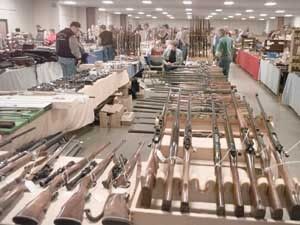
The Facts about Gun Shows
http://www.cato.org/dailys/01-10-00.html
Close the gun show loophole," demands Handgun Control, Inc. The major obstacle to Congress's complying with HCI's wishes appears to be the desire of many Democrats to preserve gun shows as a campaign issue in the 2000 election. But if the voters learn the facts about gun shows, they will discover that there is no gun show loophole, no gun show crime problem and no reason to adopt federal legislation whose main effect would be to infringe on First and Second Amendment rights.
Despite what some media commentators have claimed, existing gun laws apply just as much to gun shows as they do to any other place where guns are sold. Since 1938, persons selling firearms have been required to obtain a federal firearms license. If a dealer sells a gun from a storefront, from a room in his home or from a table at a gun show, the rules are exactly the same: he can get authorization from the FBI for the sale only after the FBI runs its "instant" background check (which often takes days to complete). As a result, firearms are the most severely regulated consumer product in the United States -- the only product for which FBI permission is required for every single sale.
Conversely, people who are not engaged in the business of selling firearms, but who sell firearms from time to time (such as a man who sells a hunting rifle to his brother-in-law), are not required to obtain the federal license required of gun dealers or to call the FBI before completing the sale.
Similarly, if a gun collector dies and his widow wants to sell the guns, she does not need a federal firearms license because she is just selling off inherited property and is not "engaged in the business." And if the widow doesn't want to sell her deceased husband's guns by taking out a classified ad in the newspaper, it is lawful for her to rent a table at a gun show and sell the entire collection.
If you walk along the aisles at any gun show, you will find that the overwhelming majority of guns offered for sale are from federally licensed dealers. Guns sold by private individuals (such as gun collectors getting rid of a gun or two over the the weekend) are the distinct minority.
Yet HCI claims that "25-50 percent of the vendors at most gun shows are unlicensed dealers." That statistic is true only if one counts vendors who aren't selling guns (e.g., vendors who are selling books, clothing or accessories) as "unlicensed dealers."
Denver congresswoman Diana DeGette says that 70 percent of guns used in crimes come from gun shows. The true figure is rather different, according to the National Institute of Justice, the research arm of the U.S. Department of Justice. According to an NIJ study released in December 1997 ("Homicide in Eight U.S. Cities," a report that covers much more than homicide), only 2 percent of criminal guns come from gun shows.
That finding is consistent with a mid-1980s study for the NIJ, which investigated the gun purchase and use habits of convicted felons in 12 state prisons. The study (later published as the book Armed and Considered Dangerous) found that gun shows were such a minor source of criminal gun acquisition that they were not even worth reporting as a separate figure.
At the most recent meeting of the American Society of Criminology, a study of youthful offenders in Michigan found that only 3 percent of the youths in the study had acquired their last handgun from a gun show. (Of course some criminal gun acquisition at gun shows is perpetrated by "straw purchasers" who are legal gun buyers acting as surrogates for the individual who wants the gun. Straw purchases have been federal felonies since 1968.)
According to the educational arm of HCI, the group's own survey of major-city police chiefs found only 2 out of 48 who said that guns from gun shows (both "legal and illegal sales" according to the questionnaire) were a major problem in their city.
Although the horrible murders at Columbine High School have energized anti-gun activists, no proposed federal law would have made any difference. The adults who supplied the Columbine murder weapons (Robin Anderson and Mark Manes -- the latter a son of a longtime HCI activist) were legal purchasers.
Since every gun show takes place entirely within the boundaries of a single state, Congress has no legitimate constitutional basis, under its "interstate commerce" power, to attempt to control gun shows.
Nevertheless, both houses of Congress have passed gun show legislation. The House bill does only what the gun control advocates claim to want: the imposition of federal background checks on personal sales at gun shows.
The Senate version -- passed 51-50 thanks to Vice President Gore -- goes much further, setting the stage for gun shows to be outlawed. The Senate bill gives the secretary of the Treasury nearly unlimited power to regulate gun show sales.
In the past, Treasury has abused its administrative authority over firearms to ban certain guns, so, similar treatment for gun shows can be expected. For example, the Treasury banned the import of various rifles that were popular for competitive target shooting. Although a federal statute specifically orders Treasury to allow the import of "sporting" firearms, Treasury claimed that only firearms that were recommended by hunting guides were "sporting."
The Senate version also imposes a tax on gun show promoters and allows the secretary of the Treasury unlimited power in setting the tax level. One can bet that, in this case, the power to tax really will be the power to destroy.
Gun shows are huge gathering points for people who are interested in Second Amendment issues. Gun rights groups frequently set up booths at gun shows to distribute literature and recruit members. Gun shows are places where Americans properly exercise their First and Second Amendment rights, and neither gun show patrons nor vendors deserve the mean-spirited campaign of abuse to which they have been subjected.
Gun Control Debate
US House Approves Stricter Gun Control Bill
http://www.rttnews.com/FOREX/gblnews.asp?date=06/14/2007&item=3
6/14/2007 2:15:54 AM The US House of Representatives on Wednesday passed a landmark bill aimed at enhancing background checks of potential gun buyers, nearly two months after a mentally disturbed student went on a rampage at the Virginia Tech.
The House passed the bill the same day the government issued a report on the Virginia Tech massacre, which said concerns over privacy laws meant data on potentially dangerous students often did not make it on to the federal gun purchase database.
The bill, if it passes the Senate, will be the first major gun control law since 1994 that would require states to provide the federal database with records of those disqualified from gun ownership and impose penalties if they fail to meet certain benchmarks.
It also allocated $250 million a year over the next three years to help states automate their systems to meet the new requirements.
The bill has been backed by the National Rifle Association, the politically powerful US gun lobby, in a rare alliance with majority Democrats in Congress.
LAW OF THE LAND
House passes gun control...sort of
New report avoids mention of tougher laws
http://www.capitolhillblue.com/cont/node/2708
The House of Representatives approved new legislation Wednesday designed to tighten gun ownership, as the government issued a report on the massacre at Virginia Tech University that omits any talk of tougher gun control laws.
House members approved by a voice-vote a bill granting financial incentives to states that report to a data base with information on people who are banned from owning guns, especially criminals and the mentally ill.
The bill is supported by the National Rifle Association (NRA), the politically powerful US gun lobby, in a rare alliance with majority Democrats in Congress.
To become law the measure must also be approved by the Senate, then signed by the president. If approved, it would become the first new gun control legislation since 1994.
The bill was drafted after the April 16 rampage in which gunman Cho Seung-Hui shot and killed 32 students and faculty on the Virginia Tech campus.
The South Korea-born, US-raised Cho, a 23-year-old English major, bought two handguns even after police and professors recognized that he was mentally disturbed.
The campus shooting "made it clear" that the national instant criminal background check system for potential gun buyers "needs to have better information, better technology, and clearer standards," said Representative John Dingell, a Democrat that co-authored the bill.
This legislation "will make a better system for public safety, law enforcement, and for lawful and honest gun owners," he said.
Democrat Charles Schumer, in charge of presenting the measure in the US Senate, said the bill is "our best opportunity to prevent the senseless loss of life at our schools and on our streets by making sure that those who are judged mentally ill do not get guns."
Also Wednesday the US government issued a report on the Virginia Tech rampage calling for better information-sharing about possibly dangerous students.
President George W. Bush commissioned an investigation of US policy after the campus shooting.
Attorney General Alberto Gonzales, Health and Human Services Secretary Michael Leavitt, and Education Secretary Margaret Spellings met with federal, state and local officials to discuss ways of preventing future tragedies.
They reported that "confusion and differing interpretations about state and federal privacy laws and regulations impede appropriate information sharing" and hamper laws designed to keep guns away from potentially dangerous people.
Task force members focused "on increasing the effectiveness of current federal firearms regulation, which is limited by divergent state practice," the report said.
At the White House, Bush said in a statement that he looks forward "to reviewing their recommendations in more detail," and said that information sharing must improve to help "keep guns out of the wrong hands and to punish those who break the law."
Regarding the House bill, Bush said: "I am closely following legislative efforts to strengthen the instant background check system. I look forward to working with Congress on this effort.
Leavitt told reporters that the study found "that in only about 23 states is information actually being reported to the instant gun check registry," which he described as "a key finding."
Bush spokesman Tony Snow said that there was no mention in the government report of expanding gun-control laws because officials decided at the outset to exclude such considerations.
"What you're asking is, why did they not consider gun control?" he asked. "Because that really wasn't within the purview of what they decided that they were going to look at."
Gun Control is Dangerous
Americans Reject Stricter Gun Control
http://www.angus-reid.com/polls/index.cfm/fuseaction/viewItem/itemID/16079
Angus Reid Global Monitor) - More people in the United States believe their country’s current firearm legislation should remain untouched, according to a poll by Rasmussen Reports. 49 per cent of respondents believe there is no need to introduce stricter gun control laws, up 12 points since mid-April.
The U.S. Constitution’s Second Amendment guarantees Americans the right "to keep and bear arms." Some American states have enacted their own gun control regulations, independent of existing federal legislation.
On Apr. 16, Cho Seung-hui killed 32 people—fellow students and teachers—at the Virginia Tech University campus in two separate incidents, before turning his gun on himself. The shooting is the deadliest of its kind in American history. 40 per cent of respondents believe stricter gun laws would have no impact on the rates of violent crimes in the country, while 37 per cent think tougher legislation would foster a reduction.
Over the past two months, almost 4,000 Americans have joined Students for Concealed Carry on Campus (SCCC), a group of gun-rights activists who advocate for allowing licensed gun owners to bring their arms to school campuses. The group believes this prerogative could prevent new episodes of school violence.
Andrew Sugg, head of the local chapter at Baylor University in Texas, said the group is "pushing for states and schools to allow licensed faculty, staff and students the right to carry concealed (weapons) on campus," adding, "Looking at the data I’ve seen so far, (banning guns on campus) does put us at more of a risk. (…) When you look at all the school shootings over the past several years, they’ve all happened in gun-free zones."
Polling Data
Does the United States need stricter gun control laws?
May 30
Apr. 19
Yes
43%
45%
No
49%
37%
Will stricter gun control laws increase or reduce violent crime?
Increase
16%
Reduce
37%
No impact
40%
Archie Bunker on Gun Control
Borat-Gun Range
Chris Rock - Gun Control
most basic gun safety rules, and an introduction into safeties and de-cock levers.
TSSA Gun Safety Video
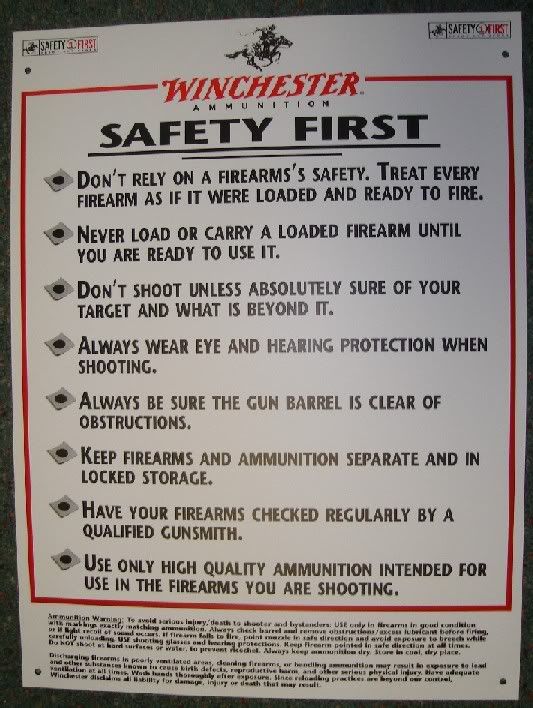
Rapid Reload
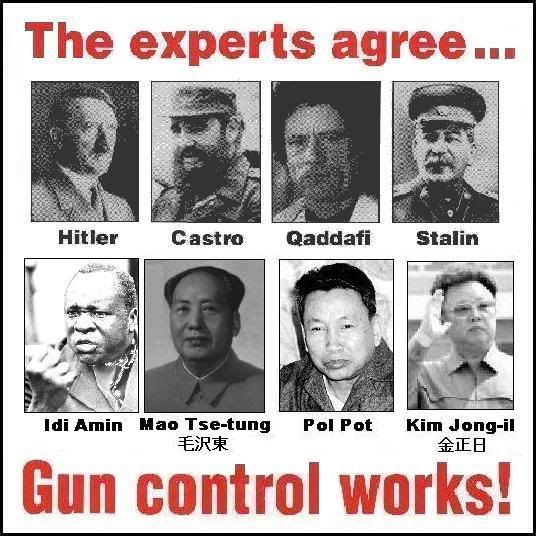
Glock 298 rounds in full auto
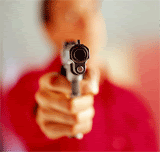
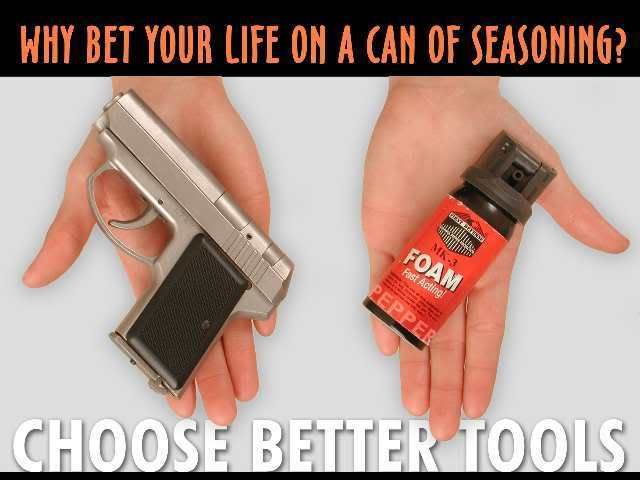
Desert Eagle .50
Girls With Guns
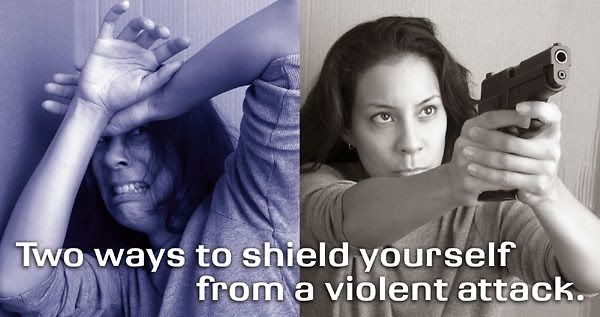


Thomas Jefferson: "No man shall ever be debarred the use of arms. The strongest reason for the people to retain the right to keep and bear arms is, as a last resort, to protect themselves against tyranny in government."
"Laws that forbid the carrying of arms... disarm only those who are neither inclined nor determined to commit crimes... Such laws make things worse for the assaulted and better for the assailants; they serve rather to encourage than to prevent homicides, for an unarmed man may be attacked with greater confidence than an armed man. "
"And what country can preserve its liberties, if its rulers are not warned from time to time, that this people preserve the spirit of resistance? Let them take arms. ... The tree of liberty must be refreshed from time to time with the blood of patriots and tyrants."

Second Amendment to the United States Constitution
Amendment II (the Second Amendment) of the United States Constitution, which is part of the Bill of Rights, declares a well regulated militia as "being necessary to the security of a free State", and prohibits Congress from infringement of "the right of the people to keep and bear arms."
http://en.wikipedia.org/wiki/Second_Amendment_to_the_United_States_Constitution
Gun politics
http://en.wikipedia.org/wiki/Gun_politics
Gun politics fundamentally involves the politics of two related questions: Does a government have valid authority to impose regulations on guns? And, assuming such authority, should a government regulate guns and to what extent?[1] The answer to these questions and the nature of the politics varies and depends on the national and local political jurisdiction.

Gun Control
http://www.policyalmanac.org/crime/guns.shtml
Congress continues to debate the efficacy and constitutionality of federal regulation of firearms and ammunition. Various federal laws have been enacted since 1934 to promote such regulation.
Gun control advocates argue that they curb access by criminals, juveniles, and other "high-risk" individuals. They contend that only federal measures can successfully reduce the availability of guns. Some seek broad policy changes such as near-prohibition of non-police handgun ownership or the registration of all firearm owners or firearms. They assert that there is no constitutional barrier to such measures and no significant social costs. Others advocate less comprehensive policies that they maintain would not impede ownership and legitimate firearm transfers.
Opposition to federal controls is strong. Gun control opponents deny that federal policies keep firearms out of the hands of high-risk persons; rather, they argue, controls often create burdens for law-abiding citizens and infringe upon constitutional rights provided by the Second Amendment. Some argue further that widespread gun ownership is one of the best deterrents to crime as well as to potential tyranny, whether by gangs or by government. They may also criticize the notion of enhancing federal, as opposed to state, police powers.
The two most significant federal statutes controlling firearms in the civilian population are the National Firearms Act of 1934 and the Gun Control Act of 1968. The 1934 Act established strict registration requirements and a transfer tax on machine guns and short-barreled long guns. The 1968 Act prohibits mail-order sales and the interstate sales of firearms, prohibits transfers to minors, limits access to "new" assault weapons, and sets forth penalties and licensing requirements for manufacturers, importers, and dealers.
Crime and mortality statistics are often used in the gun control debate. The number of homicides committed annually with a firearm by persons in the 14- to 24-year-old age group increased by 173% from 1985 to 1993, and then decreased by 47% from 1993 to 1999. Firearm fatalities from all causes and for all age groups decreased by 22%. For juveniles, they de-creased by 40%, from 1993 to 1998.
The 106 th Congress considered several measures to regulate firearms. They included 1) requiring background checks at gun shows, 2) requiring firearm safety locks, and 3) increasing controls on assault weapons and handguns. None, however, were enacted. Several dozen gun control-related proposals have been introduced in the 107 th Congress. One measure has been approved by committee: this bill (H. R. 4757) would require that a greater number of federal and state records that are pertinent to determining firearms transfer and possession eligibility be made accessible through the National Criminal Instant Background Check System (NICS). NICS performance emerged as an issue during consideration of proposals that would require background checks for firearm transfers by nonlicensed persons at gun shows. Such proposals were considered in the 106 th Congress but have not been reconsidered in the 107 th Congress to date. A discharge petition on another measure was narrowly defeated by the House: this bill (H. R. 218) would exempt certain qualified current and former law enforcement officers from state laws prohibiting concealed carry of firearms.
BACKGROUND AND ANALYSIS
Pro/ Con Debate Through the years, legislative proposals to restrict the availability of firearms to the public have raised the following questions: What restrictions on firearms are permissible under the Constitution? Does gun control constitute crime control? Can the nation's rates of homicide, robbery, and assault be reduced by the stricter regulation of firearm commerce or ownership? Would restrictions stop attacks on public figures or thwart deranged persons and terrorists? Would household, street corner, and schoolyard disputes be less lethal if firearms were more difficult and expensive to acquire? Would more restrictive gun control policies have the unintended effect of impairing citizens' means of self-defense?
In recent years, proponents of gun control legislation have often held that only federal laws can be effective in the United States. Otherwise, they say, states with few restrictions will continue to be sources of guns that flow illegally into restrictive states. They believe that the Second Amendment to the Constitution, which states that "A well regulated Militia, being necessary to the security of a free State, the right of the people to keep and bear Arms shall not be infringed," (1) is obsolete; or (2) is intended solely to guard against suppression of state militias by the central government and therefore restricted in scope by that intent; or (3) does not guarantee a right that is absolute, but one that can be limited by reasonable requirements. They ask why a private citizen needs any firearm that is not designed primarily for hunting or other recognized sporting purposes.
Proponents of firearm restrictions have advocated policy changes on specific types of firearms or components that appear to be useful primarily for criminal purposes or that pose unusual risks to the public. Fully automatic firearms (i. e., machine guns) and short-barreled rifles and shotguns have been subject to strict regulation since 1934. Fully automatic firearms have been banned from private possession since 1986, except for those legally owned and registered with the Secretary of the Treasury on May 19, 1986. More recently, "Saturday night specials" (loosely defined as inexpensive, small handguns), "assault weapons," ammunition feeding devices with capacities for more than seven rounds, and certain ammunition have been the focus of control efforts.
Opponents of gun control vary in their positions with respect to specific forms of control but generally hold that gun control laws do not accomplish what is intended. They argue that it is as difficult to keep weapons from being acquired by "high risk" individuals, even under federal laws and enforcement, as it was to stop the sale and use of liquor during Prohibition. In their view, a more stringent federal firearm regulatory system would only create problems for law-abiding citizens, bring mounting frustration and escalation of bans by gun regulators, and possibly threaten citizens' civil rights or safety. Some argue that the low violent crime rates of other countries have nothing to do with gun control, maintaining instead that multiple cultural differences are responsible.
Gun control opponents also reject the assumption that the only legitimate purpose of ownership by a private citizen is recreational (i. e., hunting and target-shooting). They insist on the continuing need of people for effective means to defend person and property, and they point to studies that they believe show that gun possession lowers the incidence of crime. They say that the law enforcement and criminal justice system in the United States has not demonstrated the ability to furnish an adequate measure of public safety. Some opponents believe further that the Second Amendment includes a right to keep arms as a defense against potential government tyranny, pointing to examples in other countries of the use of firearm restrictions to curb dissent and secure illegitimate government power.
The debate has been intense. To gun control advocates, the opposition is out of touch with the times, misinterprets the Second Amendment, or is lacking in concern for the problems of crime and violence. To gun control opponents, advocates are naive in their faith in the power of regulation to solve social problems, bent on disarming the American citizen for ideological or social reasons, or moved by irrational hostility to firearms and gun enthusiasts.
Gun-Related Statistics
Number of Guns. The National Institute of Justice (NIJ) reported in a national survey that in 1994, 44 million people, approximately 35% of households, owned 192 million firearms, 65 million of which were handguns. Seventy-four percent of those individuals were reported to own more than one firearm. The Bureau of Alcohol, Tobacco, and Firearms (ATF) estimates that as of the end of 1996, approximately 242 million firearms were available for sale to or were possessed by civilians in the United States. That total includes roughly 72 million handguns (mostly pistols, revolvers, and derringers), 76 million rifles, and 64 million shotguns.
Most guns available for sale are produced domestically. In recent years, one to two million handguns were manufactured each year, along with one million rifles and less than one million shotguns. Annual imports are considerably fewer — from 200,000 to 400,000 handguns, 200,000 rifles, and 100,000 to 200,000 shotguns. Retail prices of guns vary widely, from $50 or less for inexpensive, low-caliber handguns to more than $1,500 for high-quality rifles or shotguns. Data are not available on the number of "assault weapons" in private possession or available for sale, but estimates prepared in 1989 by a firearms expert associated with the Smithsonian Institution placed the number of such firearms at that time in the range of one to four million, less than 3% of the number of guns estimated to exist in the civilian market.
Criminal Use. Reports submitted by state and local law enforcement agencies to the Federal Bureau of Investigation (FBI) and published annually in the Uniform Crime Reports indicate that both the crime rate and the violent crime rate have declined since 1981. Of the homicides in which the type of weapon could be identified, from 60% to almost 70% have involved firearms each year. The number of homicides and the proportion involving firearms have declined in recent years. In 2000 of the 12,943 homicides reported, 66% (8,493) were committed with firearms. Of those committed with firearms, 79% (6,686) involved handguns. From 1993 to1999, the number of firearm-related homicides decreased by an average rate of nearly 11% annually, for an overall decrease of 49%. In 2000, firearm-related homicides increased slightly (by 13 homicides) to 8,493.
The other principal source of national crime data is the National Crime Victimization Survey (NCVS) conducted by the Bureau of the Census and published by the Bureau of Justice Statistics. The NCVS database provides some information on the weapons used by offenders, based on victims' reports. Based on data provided by survey respondents in calendar year 1999, BJS estimated that, nationwide, there were 6.3 million violent crimes (rape or sexual assault, robbery, aggravated assault, and simple assault). Weapons were used in about 1.6 million of these criminal incidents. Firearms were used by offenders in about 533,000 of these incidents, or roughly 8%. For further information, see Criminal Victimization 2000: Changes 1999-2000 with Trends 1993-2000, by Callie Marie Rennison [http:// www. ojp. usdoj. gov/ bjs/ pub/ pdf/ cv00. pdf].
Gun Violence and Youth. Youth crime statistics have often been used in the gun control debate. The number of homicides committed annually with a firearm by persons in the 14-to 24-year-old age group increased sharply from 1985 to 1993; they have declined since then, but not to the 1985 level. According to the Bureau of Justice Statistics, from 1985 to 1993, the number of firearm-related homicides committed by 14-to 17-year-olds increased by 294%, from 855 to 3,371. From 1993 to 1999, the number of firearm-related homicides committed by persons in this age group decreased by 65%, from 3,371 to 1,165.
From 1985 to 1993, firearm-related homicides committed by 18-to 24-year-olds increased by 142%, from 3,374 to 8,171. From 1993 to 1999, firearm-related homicides committed by persons in this age group decreased by 43%, from 8,717 to 4,973. For further information, see Homicide Trends in the United States, by James Alan Fox, at [http:// www. ojp. usdoj. gov/ bjs/ homicide/ homtrnd. htm].
Although gun-related violence in schools is statistically a rare event, a Department of Justice survey indicated that 12.7% of students age 12 to 19 reported knowing a student who brought a firearm to school. For further information, see CRS Report RL30482, The Safe and Drug-Free Schools and Communities Program: Background and Context, by Edith Fairman Cooper.
Suicides, Accidents, and Other Deaths. Firearm fatalities have decreased continuously since 1993. The source of national data on firearm deaths is the publication Vital Statistics, published each year by the National Center for Health Statistics. Firearm deaths reported by coroners in each state are presented in four categories: homicides and legal intervention, suicides, accidents, and unknown circumstances. In 1999, a total of 28,874 firearm deaths occurred, according to such reports. Of this total, 11,127 were homicides or due to legal intervention; 16,599 were suicides; 824 were unintentional (accidental) shootings; and 324 were of unknown cause. From 1993 to 1998, firearm-related deaths decreased by an average rate of 5% annually, for an overall decrease of 27%. Also in 1999, there were 1,776 juvenile (under 18 years of age) deaths attributed to firearms. Of the juvenile total, 1,010 were homicides or due to legal intervention; 558 were suicides; 158 were unintentional; and 50 were of unknown cause. From 1993 to 1999, firearm-related deaths for juveniles have decreased by an average rate of 10% annually, for an overall decrease of 46%.
Self-defense. According to the Bureau of Justice Statistics, NCVS data from 1987 to 1992 indicate that in each of those years, roughly 62,200 victims of violent crime (1% of all victims of such crimes) used guns to defend themselves. Another 20,000 persons each year used guns to protect property. Persons in the business of self-protection (police officers, armed security guards) may have been included in the survey. Another source of information on the use of firearms for self-defense is the "National Self Defense Survey" conducted by criminology professor Gary Kleck of Florida State University in the spring of 1993. Citing responses from 4,978 households, Dr. Kleck estimated that handguns have been used 2.1 million times per year for self-defense, and that all types of guns have been used approximately 2.5 million times a year for that purpose, during the 1988-1993 period.
Why do these numbers vary? Law enforcement agencies do not collect information on the number of times civilians use firearms to defend themselves or their property against attack. Such data have been collected in household surveys. The contradictory nature of the available statistics may be partially explained by methodological factors. That is, these and other criminal justice statistics reflect what is reported to have occurred, not necessarily the actual number of times certain events occur. Victims and offenders are sometimes reluctant to be candid with researchers. So, the number of criminal incidents can only be estimated, making it difficult to state with certainty the accuracy of statistics such as the number of times firearms are used in self-defense. For this and other reasons, criminal justice statistics often vary when different methodologies are applied.
Survey research can be limited, since it is difficult to produce statistically significant findings from small incident populations. For example, the sample in the National Self-Defense Survey might have been too small, given the low incidence rate and the inherent limitations of survey research.
Recreation. According to the National Institute of Justice (NIJ), in 1994 recreation was the most common motivation for owning a firearm. There were approximately 15 million hunters, about 35% of gun owners, in the United States and about the same number and percentage of gun owners engaged in sport shooting in 1994. The U. S. Fish and Wildlife Service reported that 31.6 million persons purchased hunting licenses or permits in 1993 and, according to the National Sporting Goods Association, in that year approximately 18.5 million persons took part in firearms sporting activities.
Federal Regulation of Firearms As stated in the Gun Control Act of 1968, as amended (P. L. 90-618; Title 18, United States Code, Chapter 44), the purpose of federal firearm regulation is to assist federal, state, and local law enforcement in the ongoing effort to reduce crime and violence. In the same act, however, Congress also stated that the intent of the law is not to place any undue or unnecessary burdens on law-abiding citizens in regard to the lawful acquisition, possession, or use of firearms for hunting, trapshooting, target shooting, personal protection, or any other lawful activity.
Indeed, issues related to federal firearm regulation currently under debate generally revolve around the following questions. One, who should be ineligible to possess firearms? Two, what types of firearms are appropriate for statutorily enumerated lawful firearm activities? Three, when, where, and how is it appropriate to check persons seeking to acquire a firearm for possession eligibility?
Federal Regulation of Firearm Transfers. Under current law, federal firearm licensees (hereafter referred to as licensees) may ship, transport, and receive firearms that have moved in interstate and foreign commerce. Licensees are currently required to verify with the Federal Bureau of Investigation (FBI) through a background check that nonlicensed persons are eligible to possess a firearm before subsequently transferring a firearm to them. Licensees must also verify the identity of nonlicensed transferees by inspecting a government-issued identity document, e. g., a driver's license.
Under current law, there are 9 classes of persons prohibited from possessing firearms: 1) persons convicted in any court of a crime punishable by imprisonment for a term exceeding 1 year; 2) fugitives from justice; 3) drug users, or addicts; 4) persons adjudicated mental defectives, or committed to mental institutions; 5) unauthorized immigrants; 6) persons dishonorably discharged from the Armed Forces; 7) U. S. citizenship renunciates; 8) persons under court-order restraints related to harassing, stalking, or threatening an intimate partner or child of such intimate partner; and 9) persons convicted of misdemeanor domestic violence (18 U. S. C. § 922( g)).
Licensees may engage in interstate transfers of firearms between themselves without conducting background checks. While they may transfer long guns (rifles or shotguns) to out-of-state residents, as long as there are in-person meetings and such transfers would not knowingly be in violation of the laws of the state in which the nonlicensed transferees reside, they may not transfer handguns to unlicensed out-of-state residents. Transfer of handguns by licensees to anyone under 21-years-of-age is prohibited, as is the transfer of long guns to anyone under 18-years-of-age (18 U. S. C. § 922( b)). Also, licensees are required to submit a "multiple sales reports" to the Secretary of the Treasury if any person purchases two or more handguns within 5 business days.
Furthermore, licensees are required to maintain records on all acquisitions and dispositions of firearms. They are obligated to respond to Bureau of Alcohol, Tobacco and Firearms (ATF) agents requesting firearm tracing information within 24 hours. Under certain circumstances, ATF agents may inspect, without search warrants, their business premises, inventory, and records.
On the other hand, nonlicensees are prohibited from acquiring firearms from out-of-state sources (except for long guns acquired from licensees under the scenario described above). Nonlicensees are also prohibited from transferring firearms to any persons who they have reasonable cause to believe are not residents of the state in which the transaction occurs. In addition, since 1986, it has been a federal offense for nonlicensees to knowingly transfer a firearm to prohibited persons. It is also notable that firearm transfers initiated through the Internet are subject to the same federal laws as transfers initiated in any other manner. (For further information, see CRS Report RS20957, Internet Firearm Sales, by T. J. Halstead.)
Finally, since 1994, it has been a federal offense for any nonlicensed person to transfer a handgun to anyone under 18-years-of-age. It has also been illegal for anyone under the under 18 years-of-age to possess a handgun (there are exceptions to this law related to employment, ranching, farming, target practice, and hunting) (18 U. S. C. § 922( x)).
Brady Act Implementation. According to the Bureau of Justice Statistics, since the implementation of the Brady Act on February 29, 1994, through calender year (CY) 2000, nearly 30 million firearm background checks were completed, resulting in 689,000 denials (an overall 2.3% denial rate). During the interim period of the Brady Act (phase I), from February 1994 through November 1998, there was a waiting period of up to 5 days for handgun transfers in states without instant check systems. Nearly 13 million firearm background checks were completed, resulting in 312,000 denials.
Phase II and the permanent provisions of the Brady Act became effective on November 30, 1998. As part of phase II, the Federal Bureau of Investigation rolled out the National Instant Criminal Background Check System (NICS). Through NICS, and under the permanent Brady provisions, background checks are conducted of applicants for both hand and long gun transfers. In 26 states, state agencies serve as points of contact (POCs) and conduct background checks for handgun transfers. In 16 states, state agencies serve as POCs and conduct background checks for both long gun and handgun transfers. In POC states, federal firearm licensees contact the state agency, and the state agency contacts the FBI. In non-POC states, federal firearm licensees contact the FBI directly through the NICS system.
During the first 25 months of NICS operation (through December 31, 2000), the FBI completed over 17 million background checks for firearm transfer applications. Of this number, 639,000 background checks resulted in firearm transfers being denied. Roughly half of these background checks were submitted by federal firearm licensees, and the other half by state agencies (POCs). The overall number of firearm transfer applications and required background checks declined by 11% from 8.6 million in CY1999 to 7.7 million in CY2000. Of total checks in FY2000, 2.0% (153,000) resulted in denials. Over 59% of denials occurred because the applicant was a felon or was under felony indictment, as compared to 72% in FY1999. The next most common reason for denial, about 12% of cases in FY2000, was a domestic violence misdemeanor conviction or restraining order. For further information on phase II, see Background Checks for Firearm Transfers, 2000 (Washington, July 2001), at [http:// www. ojp. usdoj. gov/ bjs/ abstract/ bcft00. htm].
According to GAO, about 75% of the NICS checks handled by the FBI resulted in immediate determinations of eligibility. Of the remaining 25% that resulted in a non-definitive response, neither a "proceed" nor a denial, 80% were turned around within 2 hours. The remaining 20% of delayed transactions took hours or days for the FBI NICS examiners to reach a final determination. In many cases these sales were delayed because there was an outstanding charge without a final disposition against the person seeking to purchase the firearm. Such cases necessitate that the FBI examiners contact local or state authorities for additional information. Under current law, the FBI is authorized to delay the sale for 3 business days in order to determine the outcome of the charge and, thus, establish the eligibility of the transferee to possess a firearm.
NICS system availability --how regularly the system can be accessed during business hours and not delay legitimate firearm transfers --has also been a source of complaint. GAO found, however, that in the first year of NICS operation, the FBI had achieved its system availability goal of 98% for 4 months. System availability for the remaining 8 months averaged 95.4%. For further information, see GAO Report GGD/ AIMD-00-64, Gun Control: Implementation of the National Instant Criminal Background Check System (Washington, February 2000).
For state agencies, background checks may not be as expeditious. Background checks through state agencies, however, may be more thorough, since state agencies may have greater access to databases and records that are not available through NICS. For further information, see National Instant Criminal Background Check System (NICS): Operations Report (November 30 1998 -December 31, 1999) (Washington, revised August 1, 1999), at [http:// www. fbi. gov/ hq/ cjisd/ nics/ index. htm], click on "NICS One Year Report."
Federal Firearm Prosecutions. Regarding enforcement of the Brady Act, from November 1998 through June 2000, the FBI referred 134,522 Brady-related cases to the ATF, and 37,926 of these cases were referred to ATF field offices for investigation. According to ATF, in FY2000 there were 1,485 defendants charged with firearm-related violations as a result of NICS checks under Brady. Of these defendants, 1,157 were charged with providing falsified information to federal firearm licensees (18 U. S. C. § 922( a)( 6)), another 86 were persons ineligible to posses firearms under the domestic violence gun ban (18 U. S. C. §§ 922( g)( 8) and (9)), and 136 were convicted felons (18 U. S. C. § 922( g)( 1)).
According to the Bureau of Justice Statistics, however, federal firearm prosecutions decreased by 19% from 1992 to 1996, they leveled off through 1997, and increased in 1998 and 1999. The decline in federal prosecutions can be attributed in part to a Supreme Court decision (Bailey v. United States (516 U. S. 137, 116 S. Ct. 501)) that limited the use of the charge of using a firearm during a violent or drug-related offense (18 United States Code, § 924( c)). See Federal Firearm Offenders, 1992-98 (with Preliminary Data for 1999) (Washington, June 2000), at [http:// www. ojp. usdoj. gov/ bjs/ pub/ pdf/ ffo98. pdf].
Major Federal Firearm Statutes. Two major federal statutes regulate the commerce in firearms, or their ownership: the National Firearms Act of 1934 (26 U. S. C. § 5801 et seq.) and the Gun Control Act of 1968, as amended (18 U. S. C. Ch. 44, § 921 et seq.). The National Firearms Act was originally designed to make it difficult to obtain types of firearms perceived to be especially lethal or to be the chosen weapons of "gangsters," most notably machine guns and short-barreled long guns. This law also regulates firearms, other than pistols or revolvers, that can be concealed on a person (e. g., pen, cane, and belt buckle guns). It taxes all aspects of the manufacture and distribution of such weapons. And, it compels the disclosure (through registration with the Secretary of the Treasury) of the production and distribution system from manufacturer to buyer.
The Gun Control Act of 1968, as amended, contains the principal federal restrictions on domestic commerce in small arms and ammunition. The statute requires all persons manufacturing, importing, or selling firearms as a business to be federally licensed; prohibits the interstate mail-order sale of all firearms; prohibits interstate sale of handguns generally, sets forth categories of persons to whom firearms or ammunition may not be sold (such as persons under a specified age or with criminal records); authorizes the Secretary of the Treasury to prohibit the importation of non-sporting firearms; requires that dealers maintain records of all commercial gun sales; and establishes special penalties for the use of a firearm in the perpetration of a federal drug trafficking offense or crime of violence. Transactions between persons "not engaged in the business" are not covered by the Act. These transactions and other matters such as possession, registration, and the issuing of licenses to the owners of firearms maybe covered by state laws or local ordinances. It also prohibits federal firearm licensees from selling or delivering a rifle or shotgun to a person under 18 years of age, or a handgun to a person under 21 years of age.
Supplementing federal law, many state firearm laws are stricter than federal law. For example, some states require permits to obtain firearms and impose a waiting period for firearm transfers. Other states are less restrictive, but state law cannot preempt federal law. Federal law serves as the minimum standard in the United States.
The following principal changes have been enacted to the Gun Control Act since 1968.
The "Firearms Owners Protection Act," McClure-Volkmer Amendments (P. L. 99-308, 1986) eases certain interstate transfer and shipment requirements for long guns, defines the term "engaged in the business," eliminates some record-keeping requirements, and bans the private possession of machine guns not legally owned prior to 1986.
The "Armor Piercing Ammunition" Ban (P. L. 99-408, 1986, amended in P. L. 103-322, 1994) prohibits the manufacture, importation and delivery of handgun ammunition composed of certain metal substances and certain full-jacketed ammunition.
The Federal Energy Management Improvement Act of 1988 (P. L. 100-615) requires that all toys or firearm look-alikes have a blazed orange plug in the barrel, denoting that it is a non-lethal imitation.
The Undetectable Firearms Act (P. L. 100-649, 1988), also known as the "plastic gun" legislation, bans the manufacture, import, possession, and transfer of firearms not detectable by security devices.
The Gun-Free School Zone Act of 1990 (P. L. 101-647), as originally enacted, was ruled unconstitutional by the U. S. Supreme Court (United States v. Lopez, 514 U. S. 549 (1995), April 26, 1995). The Act prohibited possession of a firearm in a school zone (on the campus of a public or private school or within 1,000 feet of the grounds). In response to the Court's finding that the Act exceeded Congress's authority to regulate commerce, the 104 th Congress included a provision in P. L. 104-208 that amended the Act to require federal prosecutors to include evidence that the firearms "moved in" or affected interstate commerce.
The Brady Handgun Violence Prevention Act, 1993 (P. L. 103-159) requires that background checks be completed on all nonlicensed person seeking to obtain firearms from federal firearm licensees.
The Violent Crime Control and Law Enforcement Act of 1994 (P. L. 103-322) prohibits the manufacture or importation of semiautomatic assault weapons and large capacity ammunition feeding devices (for a 10-year period). In the case of large capacity ammunition feeding devices, the ban on importation applies to those devices manufactured after September 1994. This Act provides an exception for the transfer, sale, or possession of semiautomatic assault weapons and large capacity ammunition feeding devices lawfully possessed on the date of enactment. This Act also bans the sale or transfer of handguns and handgun ammunition to, or possession of handguns and handgun ammunition by, juveniles (under 18 years of age) without prior written consent from the juvenile's parent or legal guardian; exceptions related to employment, ranching, farming, target practice, and hunting are provided. In addition, the Act disqualifies persons under court orders related to domestic abuse from receiving a firearm from any person or possessing a firearm. It also enhances penalties for the criminal use of firearms and makes other changes to existing law.
Federal Domestic Violence Gun Ban (the Lautenberg Amendment, in the Omnibus Consolidated Appropriations Act for FY1997, P. L. 104-208) prohibits persons convicted of misdemeanor crimes of domestic violence from possessing firearms and ammunition. The ban applies regardless of when the offense was adjudicated: prior to, or following enactment. It has been challenged in the federal courts, but these challenges have been defeated. (See CRS Report RL31143, Firearms Prohibitions and Domestic Violence Convictions: The Lautenberg Amendment, by T. J. Halstead.)
The Omnibus Consolidated and Emergency Appropriations Act, 1999 (P. L. 105-277), requires all federal firearm licensees to offer for sale gun storage and safety devices. It also bans firearm transfers to, or possession by, nonimmigrants who have overstayed their the terms of their temporary visa.
The Treasury, Postal and General Government Appropriations Act (P. L. 106- 58) requires that background checks be conducted when former firearm owners seek to redeem a firearm that they sold to a pawnshop.
Possible Issues for the 107 th Congress Several dozen gun control-related proposals have been introduced in the 107 th Congress. One of these measures has been approved by committee: this bill (H. R. 4757) would require that a greater number of federal and state records that are pertinent to determining firearms transfer and possession eligibility be made accessible through the National Criminal Instant Background Check System (NICS). NICS performance and robustness emerged as an issue during consideration of proposals that would require background checks for firearm transfers by nonlicensed persons at gun shows. Such proposals were considered in the 106 th Congress but have not been reconsidered in the 107 th Congress to date. In addition, a discharge petition on another measure was narrowly defeated by the House: this bill (H. R. 218) would exempt certain qualified current and former law enforcement officers from state laws prohibiting concealed carry of firearms.
Gun Shows. Federal law does not regulate gun shows specifically. Federal law regulating firearms transfers, however, is applicable to such transfers at gun shows. Federal firearm licensees – those licensed by the federal government to manufacture, import, or deal in firearms – are required to conduct background checks on non licensed persons seeking to obtain a firearm from them, by purchase or exchange. Conversely, non licensed persons – those persons who transfer firearms, but who do not meet the statutory test of being "engaged in the business" – are not required to conduct such checks. To some, this may appear to be an incongruity in the law. Why should licensees be required to conduct background checks at gun shows, and not non licensees? To others, opposed to further federal regulation of firearms, it may appear to be a continuance of the status quo, i. e., non-interference by the federal government into private firearm transfers within state lines. On the other hand, those seeking to increase federal regulation of firearms may view the absence of background checks for firearm transfers between non licensed/ private persons as a loophole in the law that needs to be closed. At issue for Congress is whether federal regulation of firearms should be expanded to include private firearm transfers at gun shows and other similar venues.
It is currently unclear what the Bush Administration's position will be on gun shows and NICS checks. During the presidential candidate debates, then candidate, now President, George W. Bush stated that he favored extending background checks to all firearm transfers at gun shows. More recently, President Bush stated that he supported such checks if they could be completed within 24 hours. Among gun show-related bills introduced in the 107 th Congress, there are basically two legislative proposals. The first, which passed the Senate in the 106 th Congress, is known by its sponsor in the 106 th Congress, former Senator Frank Lautenberg. Proposals modeled on the Lautenberg language have been included in the following bills introduced in the 107 th Congress: S. 16, S. 767, S. 940, H. R. 1990, and H. R. 4034. The last bill (H. R. 4034) was introduced by the ranking member of the Judiciary Committee, Representative John Conyers. The second proposal, introduced as S. 890, is known by its sponsors in the 107 th Congress, Senators John McCain and Joseph Lieberman. This second proposal has also been introduced in the House as H. R. 2377 by Representative Michael Castle. Both proposals address several questions.
How would the term "gun show" be defined? The Lautenberg proposal defines a gun show as any event at which 50 or more firearms are offered for sale or transfer and there are not less than 10 vendors. Instead of gun show, the McCain/ Lieberman proposal uses the term "special firearms event," defining it as any event at which 75 or more firearms are offered for sale or transfer. ! Should gun show promoters/ special firearms event operators be required to register with the Secretary of the Treasury? Both bills would require promoters/ operators to register with the Secretary of the Treasury. Unlike the Lautenberg proposal, the McCain/ Lieberman proposal would also require frequent operators who organize two or more of these events in a 6-month period to be licensed, and it would require both frequent and infrequent operators to submit ledgers of nonlicensed vendors before and after each event to the Secretary of the Treasury. ! Should all firearms transactions at gun shows be conducted by federal firearm licensees, or should a special licensee be responsible for conducting NICS checks for nonlicensees? The Lautenberg proposal adopts the former approach, the McCain/ Lieberman, the latter. Also, the McCain/ Lieberman proposal would prohibit special licensees from displaying firearms for sale or transfer at events where they are designated to conduct background checks for nonlicensees. ! How many days should the FBI be given to complete background checks at gun shows? The Lautenberg proposal does not address this issue, leaving in place the current statutory 3 business day delayed sale. In contrast, the McCain/ Lieberman proposal would establish a certification process by which states could opt for a maximum 24-hour delayed sale, when 95% of the state's disqualifying records (criminal and otherwise) going back 30 years are made available online.
For further information on gun shows, see Gun Shows: Brady Checks and Crime Gun Traces (Washington: January 1999). See: http:// www. atf. treas. gov/, click on "Publications."
Project Exile. Both gun control supporters and opponents are likely to call for greater enforcement of existing federal gun control statutes. Many maintain that "Project Exile" is a useful model upon which to build increased federal gun prosecutions. An initiative mounted by the U. S. Attorney for the Eastern District of Virginia, "Project Exile" was a concerted effort to coordinate federal, state, and local law enforcement efforts to reduce gun violence in Richmond, Virginia. At that time, Richmond had the second highest homicide rate for cities with populations of 100,000 or more. Of those homicides, 80% were committed with a firearm. As part of Project Exile, the U. S. Attorneys reviewed cases that involved felons, drug users/ traffickers, domestic violence and firearms, and these cases were singled out for prosecution in federal court. A felon caught carrying a firearm while trafficking in drugs was very likely to be sentenced to 5 years in a federal prison (18 U. S. C. § 924( c)). From 1997 to 1998, the number of homicides in Richmond dropped by 31%, and this decrease has been attributed to Project Exile. U. S. Attorneys in other major metropolitan areas have adopted this approach.
In the 106 th Congress, the House passed the Project Exile: The Safe Streets and Neighborhoods Act of 2000 (H. R. 4051). This bill would have amended the Violent Crime Control and Law Enforcement Act of 1994 (P. L. 103-322) to create a program to provide firearms sentencing incentive grants to encourage states to adopt programs that would be similar to Project Exile. For similar legislation introduced in the 107 th Congress, see H. R. 534, S. 16, and S. 619.
Background Check Record Retention and Fees. Attorney General John Ashcroft recently announced that National Instant Background Check System (NICS) records on approved sales would be destroyed after 24 hours retention. He maintains that to keep these records longer was a violation of federal law. Previously, the Department of Justice published a rule that would reduce from 6 to 3 months the length of time that the Federal Bureau of Investigation would retain such information on approved sales (see 64 Fed. Reg. 10263-10265, March 3, 1999). The National Rifle Association (NRA) had challenged the DOJ rule to retain the records on approved sales for 6 months in federal court. On July 11, 2000, however, the United States Court of Appeals for the District of Columbia, in the case of NRA v. Reno (No. 99-5270, 216 F. 3d 122; 2000 U. S. App. Lexis 15906), found that nothing in the Brady Handgun Violence Prevention Act prohibits the temporary retention of information about lawful firearm transfers. According to GAO, next-day destruction of records may not adversely affect routine NICS audits to determine the accuracy of eligibility decisions made by NICS examiners, if such audits are done on an hourly or daily basis. However, next-day destruction of records may adversely affect non-routine audits, such as when a law enforcement agency requests information about a firearm transfer that NICS records show was allowed, but subsequent information shows that the transferee was ineligible to receive a firearm. For further information, see GAO Report GAO-02-653, Gun Control: Potential Effects of Next-Day Destruction of NICS Background Check Records (Washington: July 2002).
In regard to fees, the FY2002 Commerce-Justice-State appropriations act (P. L. 107-77) includes a provision that prohibits user fees being charged for background checks under the Brady Handgun Prevention Act.
Federal and State Background Check Records. The House Judiciary Committee amended and approved a bill to improve the National Instant Background Check System (NICS) on July 23, 2002. This bill, "Our Lady of Peace Act" (H. R. 4757), was introduced by Representative Carolyn McCarthy. Among other things, this bill would: (1) amend the Brady Handgun Violence Prevention Act to require federal agencies to provide, and the Attorney General to secure, any government records with information relevant to determining the eligibility of a person to receive a firearm for inclusion in NICS; (2) require states to make available to the Attorney General certain records that would disqualify persons from acquiring a firearm, particularly those records that relate to convictions for misdemeanor crimes of domestic violence and persons adjudicated as mental defective; and (3) authorize appropriations for grant programs to assist states, courts, and local governments in establishing or improving such automated record systems.
Concealed Carry. Several bills introduced in the 107 th Congress would exempt certain qualified current and former law enforcement officers from state laws prohibiting concealed carry of firearms (H. R. 218, H. R. 255, H. R. 382, S. 442, and S. 2480). The most recent bill (S. 2480) was introduced by Senator Patrick Leahy – the Chair of the Senate Judiciary Committee, and Senator Orrin Hatch – the committee's ranking minority member, at the request of the Fraternal Order of Police. The Senate bill is nearly identical to a measure (H. R. 218) introduced by Representative Randy Cunningham. A discharge petition on H. R. 218, which would have required House consideration of this bill, was narrowly defeated on November 13, 2001. Concealed carry of firearms has traditionally been a matter of state law. In states that allow concealed carry, there are two types of laws: "may issue" and "shall issue." States with discretionary, or "may issue," laws leave the decision to issue or deny permits with the issuing authority (usually the state police). States with non-discretionary, or "shall issue," laws require that permits be issued to applicants who meet certain criteria.

SO YOUWANNA KNOW ABOUT GUN CONTROL?
http://www.soyouwanna.com/site/pros_cons/guncontrol/guncontrol.html


Milestones in Federal
Gun Control Legislation
http://www.infoplease.com/spot/guntime1.html

This listing of facts is derived from over 200 hours of research and analysis of more than 100 articles, documents, and books. Every statistic from a given year was chosen based on availability, and not to slant the results by singling out a specific year that was different from others. Especially when dealing with statistics, the determination of what constitutes a credible fact and what does not, can contain elements of personal subjectivity. It is our mission to minimize subjective information and to provide highly factual content. Therefore, we are taking the additional step of giving our readers a tool to determine for themselves the viability of our work. To that end, we have provided four examples to illustrate the type of material that was excluded because it did not meet Just Facts' Standards of Credibility.
http://www.justfacts.com/issues.guncontrol.asp

The history of gun control, part 1
http://worldnetdaily.com/news/article.asp?ARTICLE_ID=56047
Philosopher George Santayana said that those who cannot remember the past are condemned to repeat it. It's true. One of the reasons to study history is to avoid repeating past mistakes. When it comes to freedom, we cannot afford to forget the lessons of the past. So you and I need to know the history of gun control, because history teaches us there is a terrible price to pay when we lose our right to keep and bear arms.
Over 200 years ago, when the Founding Fathers drafted the Second Amendment, no one questioned the need for private gun ownership. The Framers considered private firearms to be essential to protecting personal liberty, both as a means of opposing foreign threats and also as a check against excessive government power. The Framers were passionately devoted to the idea that a self-sufficient armed citizenry is the best means of preserving liberty.
But many on the left do not want you to know this. They keep the truth from being taught in public schools, and they even write books laden with falsehoods in a dishonest attempt to rewrite history.
Seven years ago, Emory University historian Michael Bellesiles published a book purportedly proving there were few guns and gun owners in early America. The book garnered Columbia University's coveted Bancroft Prize. Two years later, primarily due to the efforts of a brilliant young research historian, Clayton Cramer, who had studied that period in history extensively, the book was revealed to be a total fraud, full of lies and fabrications. Bellesiles was forced to resign from Emory University and, for the first time in history, Columbia University rescinded the Bancroft Prize.
Every American who values his or her constitutional rights should know something about these frauds that gun control advocates perpetrate so we can be watchful and teach the truth to our young ones.
Early Americans were gun owners. Private firearm ownership was widespread from the coasts to the frontier, in both the North and the South.
Our ancestors not only knew the value of gun rights, they actually practiced those rights. Many early Americans provided for their family through their skill with a firearm, and many more Americans had a gun hanging over the hearth or in the bedroom to protect the house and the children against wild animals or criminals. These firearms were also seen as an insurance policy against American Indians, the British or French, and even against our own central government.
This honored tradition went completely unchallenged until the 1900s. Then New York passed the Sullivan Act in 1911, one of the first gun control laws. This law required that firearms small enough to be concealed on a person be registered. This state law became a test measure for future gun control laws.
Opponents of the Second Amendment started to mobilize at the federal level in the 1930s. It came during the New Deal, when the federal government was growing rapidly. Two laws enacted during this period, the National Firearms Act of 1934 and the Federal Firearms Act of 1938, established the first federal gun controls. While most of these regulations were uncontroversial by current standards (such as licensing gun dealers and regulating possession of machine guns), they introduced the concept of national regulation of firearms.
It was also during this time President Franklin Roosevelt appointed a number of liberals to the United States Supreme Court. Starting in 1937, the high court began moving in a liberal direction, and by the 1960s had become a court favoring full judicial activism, a judicial philosophy that has threatened our Second Amendment rights ever since.
During this period, anti-Second Amendment politicians began testing the waters on gun control. The highest-ranking official to do this was FDR's anti-gun attorney general, Homer Cummings. Attorney General Cummings started planning for federal gun control measures such as a national registry in the hands of the central government for guns and gun owners.
But then World War II broke out, and Germany and Japan invaded their neighbors. The American people were reminded how important it is to have a firearm handy when you need one. Cummings' early attempts to regulate guns and gun owners suddenly became unpopular. Gun control advocates lowered their voices until a more opportune time.
Most American leaders in both political parties were pro-gun. In fact, Democratic presidents Harry Truman and John F. Kennedy were NRA members. Gun control advocates were always present in policy debates, but did not have much political clout.
In the 1960s, gun control came back with a vengeance. Modern liberalism became the dominant political philosophy in this country. And after the deaths of JFK, Robert Kennedy and Martin Luther King Jr., an all-out national push for gun control was launched.
This period in the late 1960s was the beginning of significant gun control in America. Liberal activist judges, led by the Warren Court, enacted a widespread liberal agenda. American society was being secularized. President Johnson was forcing a hard-left agenda through the Great Society. And the Vietnam War was becoming increasingly unpopular. It was against that backdrop the left finally launched an open, concerted effort to implement national gun control.
And that's what we'll talk about next week, remembering that if we ignore the lessons that history offers us, our children will pay the price with their freedom.
The history of gun control, part 2
http://worldnetdaily.com/news/article.asp?ARTICLE_ID=56156
Until Lyndon Johnson came to the White House in 1963 following the assassination of President John F. Kennedy, gun control was simply not a national issue. There were no significant federal gun control laws on the books, and the NRA was a shooter's organization that intentionally shied away from any political involvement.
All of that changed with the 1968 assassinations of Sen. Robert Kennedy and civil rights leader Martin Luther King. In the civil unrest that followed, the media found a new whipping boy – America's gun owners. The media blitz against gun rights was unprecedented and became the driving force behind Democrat leaders proposing national gun control.
Although JFK and his brother, Sen. Robert Kennedy, had been NRA Life Members, America's new president, Lyndon Johnson, was a committed gun control advocate. No president ever matched his power and his will when it came to controlling the legislative process. His attorney general and much of his senior staff searched for new ways to restrict gun ownership among the American people. This was part of Johnson's Great Society vision of an all-powerful federal government controlling the lives of ordinary Americans.
LBJ also put anti-gun judges on the federal courts at every level. Liberal Thurgood Marshall, an opponent of the Second Amendment, was appointed to the United States Supreme Court. All three branches of the federal government lurched to the left in most policy areas, including firearms.
Keep in mind that up until this time, private ownership of firearms was not in any meaningful way controlled by the federal government. Johnson's administration was the beginning of the federal government superseding state authority in all aspects of people's lives, including ownership and lawful commerce in their private property – in this case, firearms.
The other major factor that created the federal gun control movement was that the NRA, as an organization, was totally unprepared to deal with the media, Lyndon Johnson, or the anti-gun politicians in the U.S. House and Senate. Up until that point, NRA refused even to have a registered lobbyist. In fact, NRA sent mixed signals to the Hill in reference to Johnson's anti-gun legislation.
If NRA had held nominally pro-gun House members' feet to the fire, the 1968 Gun Control Act, or GCA, would not have become law. With no direction from NRA, however, those legislators simply didn't vote. And the worst piece gun control legislation in history was enacted into law.
GCA made many common gun-related commercial activities federal crimes. Suddenly, firearm sales became heavily regulated and restricted. Some supporters of GCA saw it as the first step toward the ultimate goal of ending private gun ownership in the United States. The GCA has served as the basis of virtually every piece of gun control legislation, federal or state, that has been enacted since.
Nothing changed politically for gun owners until former NRA President Harlon Carter, a true visionary and often a lone voice on the NRA board, convinced NRA that gun owners needed a powerful grass-roots lobby focused on saving the Second Amendment.
Following Senate passage of a Saturday Night Special bill, which would have banned one-third of the handgun designs in the United States, Harlon Carter got his way. NRA created the NRA Institute for Legislative Action, or ILA, in 1975.
With the creation of ILA, Carter and his small band of young staffers – talented communicators, lawyers, lobbyists, and grass-roots organizers – turned the battle on its head.
Just months after ILA was created, gun owners celebrated a remarkable victory when ILA helped U.S. Sen. James McClure personally hand Massachusetts anti-gun rights Sen. Edward Kennedy an equally stunning defeat.
Kennedy wanted handgun ammunition banned by the Consumer Product Safety Commission as a "hazardous substance." When it came to a roll call vote, 75 senators – among them a majority of Democrats – voted against Kennedy's gun control scheme. Only 11 senators stood with Kennedy. The dynamic had changed. At last, frustrated gun owners across the country welcomed a real Second Amendment lobby.
With his singular vision of the future, Harlon Carter began recruiting young scholars, writers, researchers and lawyers who fervently believed in the Second Amendment as an individual right. Carter often said that we would see the day when these young men and women would be old and wise and their ideas powerful.
In my next column, I'll talk about what went wrong in the '70s and how grass-roots gun-rights activists worked with NRA to fix it.
Bookmark for part 3
Myth: Gun Control Reduces Crime
Gun Control: Myths and Realities
http://www.cato.org/dailys/05-13-00.html
The number of well-publicized public shootings during the past few years, especially the tragedy at Columbine High School, has re-energized the gun control movement. As a show of strength, a coalition of gun control groups has organized a "Million Mom March" to be held in Washington, D.C. on Mother's Day, an event designed to stir up emotions rather than promote rational thought. And when one looks at the facts about gun control, it's easy to see why the anti-gun lobby relies on emotion rather than logic to make its case.
Think you know the facts about gun control? If your only source of information is the mainstream media, what you think you know may not be correct. Take the quiz below and test your knowledge.
1. Thousands of children die annually in gun accidents.
False. Gun accidents involving children are actually at record lows, although you wouldn't know it from listening to the mainstream media. In 1997, the last year for which data are available, only 142 children under 15 years of age died in gun accidents, and the total number of gun-related deaths for this age group was 642. More children die each year in accidents involving bikes, space heaters or drownings. The often repeated claim that 12 children per day die from gun violence includes "children" up to 20 years of age, the great majority of whom are young adult males who die in gang-related violence.
2. Gun shows are responsible for a large number of firearms falling into the hands of criminals.
False. Contrary to President Clinton's claims, there is no "gun show loophole." All commercial arms dealers at gun shows must run background checks, and the only people exempt from them are the small number of non-commercial sellers. According to the U.S. Department of Justice, at most 2 percent of guns used by criminals are purchased at gun shows, and most of those were purchased legally by people who passed background checks.
3. The tragedy at Columbine High School a year ago illustrates the deficiencies of current gun control laws.
False. Eric Harris and Dylan Klebold violated close to 20 firearms laws in amassing their cache of weapons (not to mention the law against murder), so it seems rather dubious to argue that additional laws might have prevented this tragedy. The two shotguns and rifle used by Harris and Klebold were purchased by a girlfriend who would have passed a background check, and the TEC-9 handgun used by them was already illegal.
4. States that allow registered citizens to carry concealed weapons have lower crime rates than those that don't.
True. The 31 states that have "shall issue" laws allowing private citizens to carry concealed weapons have, on average, a 24 percent lower violent crime rate, a 19 percent lower murder rate and a 39 percent lower robbery rate than states that forbid concealed weapons. In fact, the nine states with the lowest violent crime rates are all right-to-carry states. Remarkably, guns are used for self-defense more than 2 million times a year, three to five times the estimated number of violent crimes committed with guns.
5. Waiting periods lower crime rates.
False. Numerous studies have been conducted on the effects of waiting periods, both before and after the federal Brady bill was passed in 1993. Those studies consistently show that there is no correlation between waiting periods and murder or robbery rates. Florida State University professor Gary Kleck analyzed data from every U.S. city with a population over 100,000 and found that waiting periods had no statistically significant effect. Even University of Maryland anti-gun researcher David McDowell found that "waiting periods have no influence on either gun homicides or gun suicides."
6. Lower murder rates in foreign countries prove that gun control works.
False. This is one of the favorite arguments of gun control proponents, and yet the facts show that there is simply no correlation between gun control laws and murder or suicide rates across a wide spectrum of nations and cultures. In Israel and Switzerland, for example, a license to possess guns is available on demand to every law-abiding adult, and guns are easily obtainable in both nations. Both countries also allow widespread carrying of concealed firearms, and yet, admits Dr. Arthur Kellerman, one of the foremost medical advocates of gun control, Switzerland and Israel "have rates of homicide that are low despite rates of home firearm ownership that are at least as high as those in the United States." A comparison of crime rates within Europe reveals no correlation between access to guns and crime.
The basic premise of the gun control movement, that easy access to guns causes higher crime, is contradicted by the facts, by history and by reason. Let's hope more people are catching on.

Gun Show 2006
Arkansas Gun Show

The Facts about Gun Shows
http://www.cato.org/dailys/01-10-00.html
Close the gun show loophole," demands Handgun Control, Inc. The major obstacle to Congress's complying with HCI's wishes appears to be the desire of many Democrats to preserve gun shows as a campaign issue in the 2000 election. But if the voters learn the facts about gun shows, they will discover that there is no gun show loophole, no gun show crime problem and no reason to adopt federal legislation whose main effect would be to infringe on First and Second Amendment rights.
Despite what some media commentators have claimed, existing gun laws apply just as much to gun shows as they do to any other place where guns are sold. Since 1938, persons selling firearms have been required to obtain a federal firearms license. If a dealer sells a gun from a storefront, from a room in his home or from a table at a gun show, the rules are exactly the same: he can get authorization from the FBI for the sale only after the FBI runs its "instant" background check (which often takes days to complete). As a result, firearms are the most severely regulated consumer product in the United States -- the only product for which FBI permission is required for every single sale.
Conversely, people who are not engaged in the business of selling firearms, but who sell firearms from time to time (such as a man who sells a hunting rifle to his brother-in-law), are not required to obtain the federal license required of gun dealers or to call the FBI before completing the sale.
Similarly, if a gun collector dies and his widow wants to sell the guns, she does not need a federal firearms license because she is just selling off inherited property and is not "engaged in the business." And if the widow doesn't want to sell her deceased husband's guns by taking out a classified ad in the newspaper, it is lawful for her to rent a table at a gun show and sell the entire collection.
If you walk along the aisles at any gun show, you will find that the overwhelming majority of guns offered for sale are from federally licensed dealers. Guns sold by private individuals (such as gun collectors getting rid of a gun or two over the the weekend) are the distinct minority.
Yet HCI claims that "25-50 percent of the vendors at most gun shows are unlicensed dealers." That statistic is true only if one counts vendors who aren't selling guns (e.g., vendors who are selling books, clothing or accessories) as "unlicensed dealers."
Denver congresswoman Diana DeGette says that 70 percent of guns used in crimes come from gun shows. The true figure is rather different, according to the National Institute of Justice, the research arm of the U.S. Department of Justice. According to an NIJ study released in December 1997 ("Homicide in Eight U.S. Cities," a report that covers much more than homicide), only 2 percent of criminal guns come from gun shows.
That finding is consistent with a mid-1980s study for the NIJ, which investigated the gun purchase and use habits of convicted felons in 12 state prisons. The study (later published as the book Armed and Considered Dangerous) found that gun shows were such a minor source of criminal gun acquisition that they were not even worth reporting as a separate figure.
At the most recent meeting of the American Society of Criminology, a study of youthful offenders in Michigan found that only 3 percent of the youths in the study had acquired their last handgun from a gun show. (Of course some criminal gun acquisition at gun shows is perpetrated by "straw purchasers" who are legal gun buyers acting as surrogates for the individual who wants the gun. Straw purchases have been federal felonies since 1968.)
According to the educational arm of HCI, the group's own survey of major-city police chiefs found only 2 out of 48 who said that guns from gun shows (both "legal and illegal sales" according to the questionnaire) were a major problem in their city.
Although the horrible murders at Columbine High School have energized anti-gun activists, no proposed federal law would have made any difference. The adults who supplied the Columbine murder weapons (Robin Anderson and Mark Manes -- the latter a son of a longtime HCI activist) were legal purchasers.
Since every gun show takes place entirely within the boundaries of a single state, Congress has no legitimate constitutional basis, under its "interstate commerce" power, to attempt to control gun shows.
Nevertheless, both houses of Congress have passed gun show legislation. The House bill does only what the gun control advocates claim to want: the imposition of federal background checks on personal sales at gun shows.
The Senate version -- passed 51-50 thanks to Vice President Gore -- goes much further, setting the stage for gun shows to be outlawed. The Senate bill gives the secretary of the Treasury nearly unlimited power to regulate gun show sales.
In the past, Treasury has abused its administrative authority over firearms to ban certain guns, so, similar treatment for gun shows can be expected. For example, the Treasury banned the import of various rifles that were popular for competitive target shooting. Although a federal statute specifically orders Treasury to allow the import of "sporting" firearms, Treasury claimed that only firearms that were recommended by hunting guides were "sporting."
The Senate version also imposes a tax on gun show promoters and allows the secretary of the Treasury unlimited power in setting the tax level. One can bet that, in this case, the power to tax really will be the power to destroy.
Gun shows are huge gathering points for people who are interested in Second Amendment issues. Gun rights groups frequently set up booths at gun shows to distribute literature and recruit members. Gun shows are places where Americans properly exercise their First and Second Amendment rights, and neither gun show patrons nor vendors deserve the mean-spirited campaign of abuse to which they have been subjected.
Gun Control Debate
US House Approves Stricter Gun Control Bill
http://www.rttnews.com/FOREX/gblnews.asp?date=06/14/2007&item=3
6/14/2007 2:15:54 AM The US House of Representatives on Wednesday passed a landmark bill aimed at enhancing background checks of potential gun buyers, nearly two months after a mentally disturbed student went on a rampage at the Virginia Tech.
The House passed the bill the same day the government issued a report on the Virginia Tech massacre, which said concerns over privacy laws meant data on potentially dangerous students often did not make it on to the federal gun purchase database.
The bill, if it passes the Senate, will be the first major gun control law since 1994 that would require states to provide the federal database with records of those disqualified from gun ownership and impose penalties if they fail to meet certain benchmarks.
It also allocated $250 million a year over the next three years to help states automate their systems to meet the new requirements.
The bill has been backed by the National Rifle Association, the politically powerful US gun lobby, in a rare alliance with majority Democrats in Congress.
LAW OF THE LAND
House passes gun control...sort of
New report avoids mention of tougher laws
http://www.capitolhillblue.com/cont/node/2708
The House of Representatives approved new legislation Wednesday designed to tighten gun ownership, as the government issued a report on the massacre at Virginia Tech University that omits any talk of tougher gun control laws.
House members approved by a voice-vote a bill granting financial incentives to states that report to a data base with information on people who are banned from owning guns, especially criminals and the mentally ill.
The bill is supported by the National Rifle Association (NRA), the politically powerful US gun lobby, in a rare alliance with majority Democrats in Congress.
To become law the measure must also be approved by the Senate, then signed by the president. If approved, it would become the first new gun control legislation since 1994.
The bill was drafted after the April 16 rampage in which gunman Cho Seung-Hui shot and killed 32 students and faculty on the Virginia Tech campus.
The South Korea-born, US-raised Cho, a 23-year-old English major, bought two handguns even after police and professors recognized that he was mentally disturbed.
The campus shooting "made it clear" that the national instant criminal background check system for potential gun buyers "needs to have better information, better technology, and clearer standards," said Representative John Dingell, a Democrat that co-authored the bill.
This legislation "will make a better system for public safety, law enforcement, and for lawful and honest gun owners," he said.
Democrat Charles Schumer, in charge of presenting the measure in the US Senate, said the bill is "our best opportunity to prevent the senseless loss of life at our schools and on our streets by making sure that those who are judged mentally ill do not get guns."
Also Wednesday the US government issued a report on the Virginia Tech rampage calling for better information-sharing about possibly dangerous students.
President George W. Bush commissioned an investigation of US policy after the campus shooting.
Attorney General Alberto Gonzales, Health and Human Services Secretary Michael Leavitt, and Education Secretary Margaret Spellings met with federal, state and local officials to discuss ways of preventing future tragedies.
They reported that "confusion and differing interpretations about state and federal privacy laws and regulations impede appropriate information sharing" and hamper laws designed to keep guns away from potentially dangerous people.
Task force members focused "on increasing the effectiveness of current federal firearms regulation, which is limited by divergent state practice," the report said.
At the White House, Bush said in a statement that he looks forward "to reviewing their recommendations in more detail," and said that information sharing must improve to help "keep guns out of the wrong hands and to punish those who break the law."
Regarding the House bill, Bush said: "I am closely following legislative efforts to strengthen the instant background check system. I look forward to working with Congress on this effort.
Leavitt told reporters that the study found "that in only about 23 states is information actually being reported to the instant gun check registry," which he described as "a key finding."
Bush spokesman Tony Snow said that there was no mention in the government report of expanding gun-control laws because officials decided at the outset to exclude such considerations.
"What you're asking is, why did they not consider gun control?" he asked. "Because that really wasn't within the purview of what they decided that they were going to look at."
Gun Control is Dangerous
Americans Reject Stricter Gun Control
http://www.angus-reid.com/polls/index.cfm/fuseaction/viewItem/itemID/16079
Angus Reid Global Monitor) - More people in the United States believe their country’s current firearm legislation should remain untouched, according to a poll by Rasmussen Reports. 49 per cent of respondents believe there is no need to introduce stricter gun control laws, up 12 points since mid-April.
The U.S. Constitution’s Second Amendment guarantees Americans the right "to keep and bear arms." Some American states have enacted their own gun control regulations, independent of existing federal legislation.
On Apr. 16, Cho Seung-hui killed 32 people—fellow students and teachers—at the Virginia Tech University campus in two separate incidents, before turning his gun on himself. The shooting is the deadliest of its kind in American history. 40 per cent of respondents believe stricter gun laws would have no impact on the rates of violent crimes in the country, while 37 per cent think tougher legislation would foster a reduction.
Over the past two months, almost 4,000 Americans have joined Students for Concealed Carry on Campus (SCCC), a group of gun-rights activists who advocate for allowing licensed gun owners to bring their arms to school campuses. The group believes this prerogative could prevent new episodes of school violence.
Andrew Sugg, head of the local chapter at Baylor University in Texas, said the group is "pushing for states and schools to allow licensed faculty, staff and students the right to carry concealed (weapons) on campus," adding, "Looking at the data I’ve seen so far, (banning guns on campus) does put us at more of a risk. (…) When you look at all the school shootings over the past several years, they’ve all happened in gun-free zones."
Polling Data
Does the United States need stricter gun control laws?
May 30
Apr. 19
Yes
43%
45%
No
49%
37%
Will stricter gun control laws increase or reduce violent crime?
Increase
16%
Reduce
37%
No impact
40%
Archie Bunker on Gun Control
Borat-Gun Range
Chris Rock - Gun Control
most basic gun safety rules, and an introduction into safeties and de-cock levers.
TSSA Gun Safety Video

Rapid Reload

Glock 298 rounds in full auto


Desert Eagle .50
Girls With Guns

Are you for or against guns?

Subscribe to:
Comments (Atom)














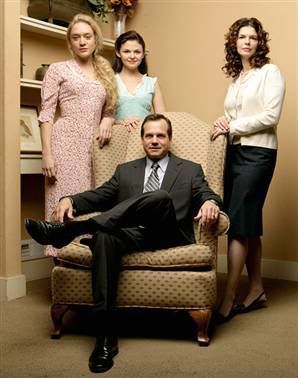

















![Brotherhood" (2006) [TV-Series]](http://photos1.blogger.com/x/blogger2/1421/379621144723082/211/z/425926/gse_multipart33129.jpg)






